ASSALOY SCYMCA1 Aperio V3 iN100 RF Module User Manual FM403 IN100 Mortise Instr
ASSA ABLOY Inc. Aperio V3 iN100 RF Module FM403 IN100 Mortise Instr
ASSALOY >
Contents
- 1. User Manual - A8190B IN100 (V3) Bored
- 2. User Manual - A8190B IN100 (V3) Mortise
- 3. User Manual - FM403 IN100 Mortise Instr
- 4. User Manual - FM404 IN100 Bored Instr
- 5. MANUAL
- 6. MANUAL - MODULE INTEGRATION
User Manual - FM403 IN100 Mortise Instr
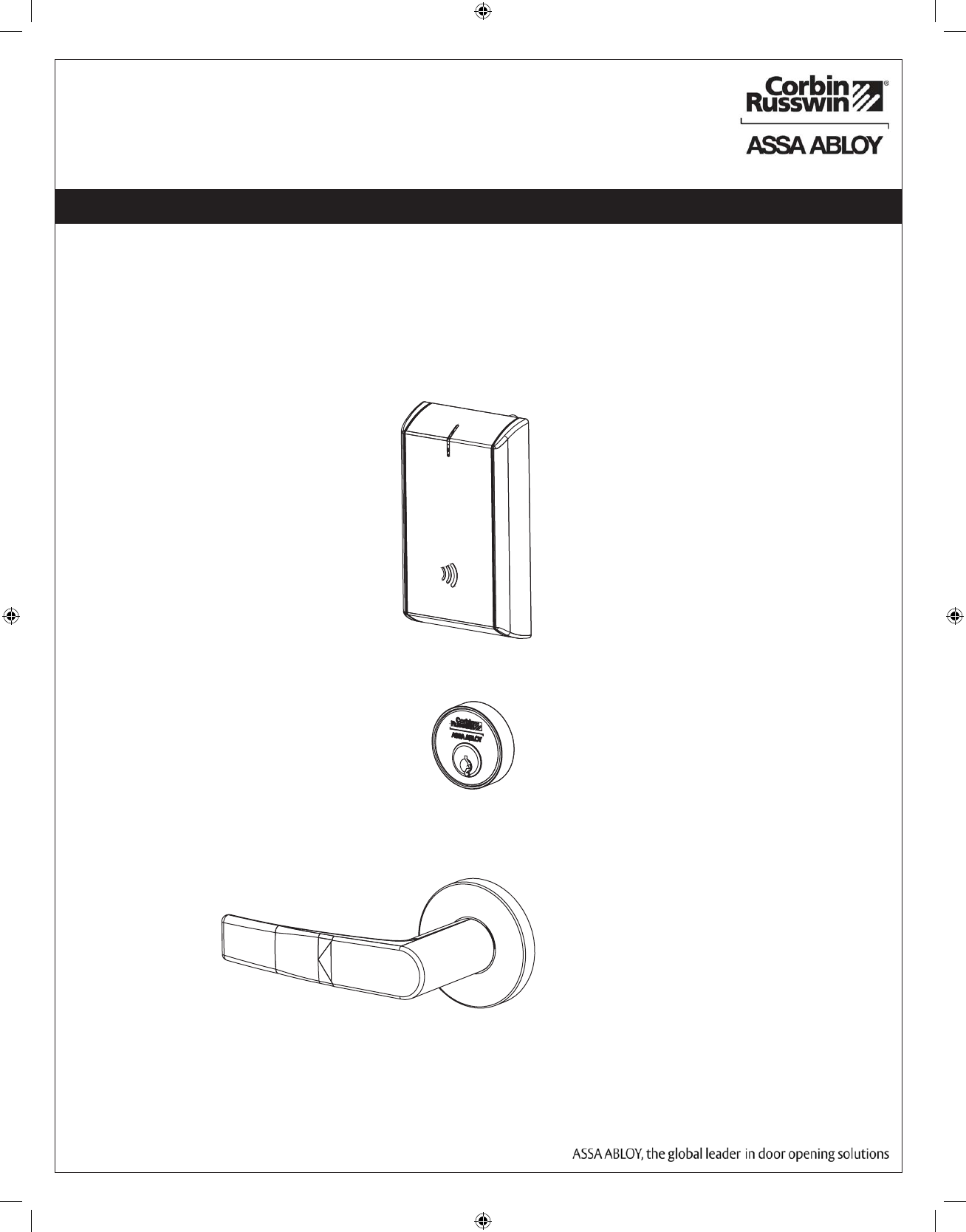
FM403 07/16
Please read these instructions carefully to prevent missing important steps.
Please Note: Improper installations may result in damage to the lock and void the factory warranty.
Important: The accuracy of the door preparation is critical for proper functioning and security of this lock.
Misalignment can cause premature wear and a lessening of security.
For Technical Assistance call Corbin Russwin at 1-800-810-WIRE (9473)
Copyright © 2016 Corbin Russwin, Inc., an ASSA ABLOY Group company.
All rights reserved. Reproduction in whole or in part without the
express written permission of Corbin Russwin, Inc. is prohibited.
Attention Installer
Mortise Lockset
IN100 WiFi
Installation Instructions
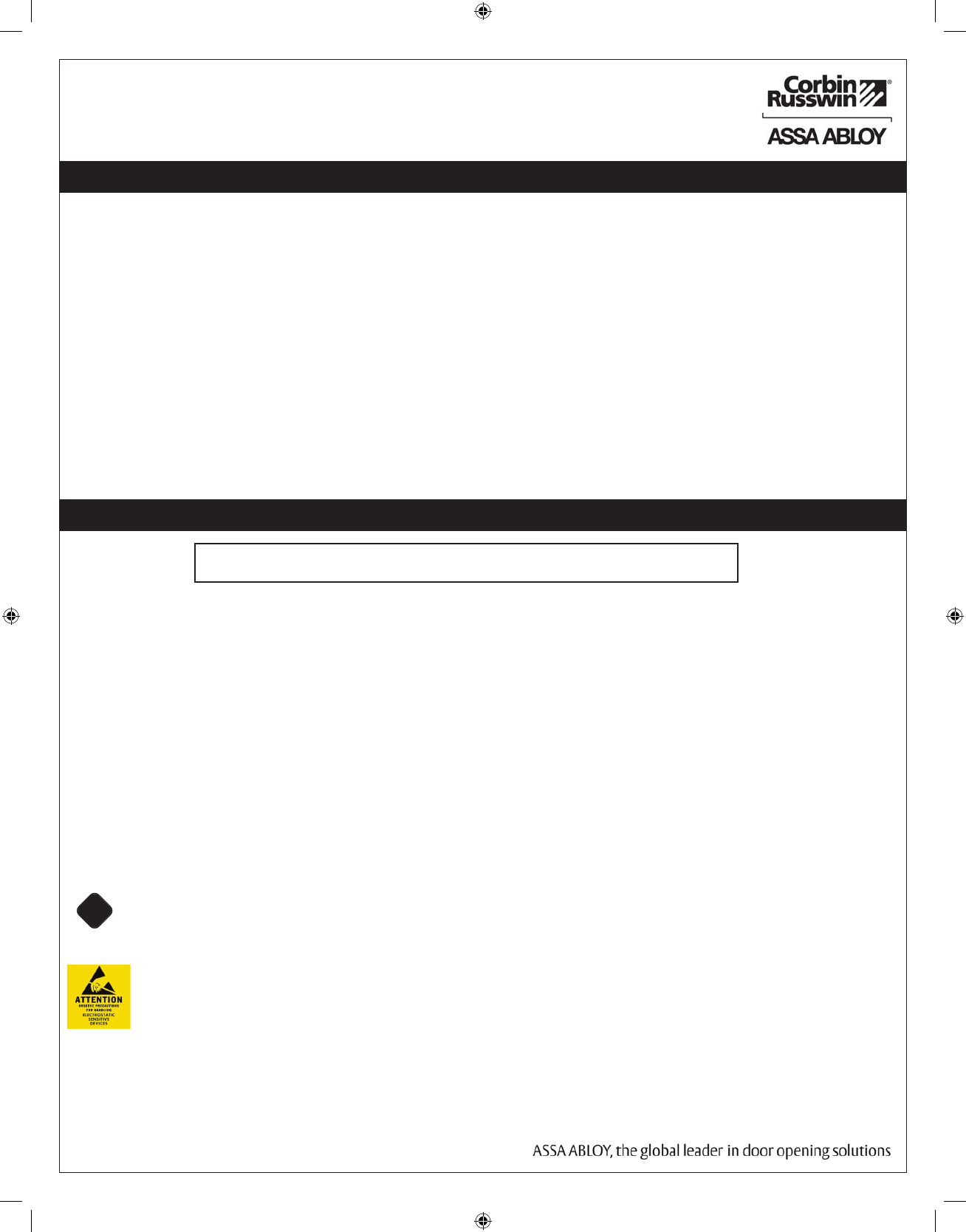
IN100 Mortise Lock
1) Warning
Table of Contents
2
1) Warning ................................................................................2
2) General Description .............................................................3
3) Specifications / Features ....................................................3
4) Product Illustrations ............................................................4
5) Installation Instructions ......................................................6
6) Operational Check .............................................................20
7) LED Indications .................................................................21
!
Copyright © 2016 Corbin Russwin, Inc., an ASSA ABLOY Group company.
All rights reserved. Reproduction in whole or in part without the
express written permission of Corbin Russwin, Inc. is prohibited.
This device complies with Part 15 of the FCC Rules. Operation is subject to the following two conditions: (1) this device may not cause
harmful interference, and (2) this device must accept any interference received, including interference that may cause undesired operation.
Note: This equipment has been tested and found to comply with the limits for a Class B digital device, pursuant to Part 15 of the FCC Rules.
These limits are designed to provide reasonable protection against harmful interference in a residential installation.
This equipment generates, uses and can radiate radio frequency energy and if not installed and used in accordance with the instructions,
may cause harmful interference to radio communications. However, there is no guarantee that the interference will not occur in a particular
installation. If this equipment does cause harmful interference to radio or television reception, which can be determined by turning the equip-
ment off and on, the user is encouraged to try to correct the interference by one or more of the following measures:
• Reorient or relocate the receiving antenna
• Increase the separation between the equipment and receiver
• Connect the equipment into an outlet on a circuit different from that to which the receiver is connected
• Consult the dealer or an experienced technician for help
The term “IC:” before the radio certification number only signifies that Industry Canada technical specifications were met. This Class B digital
apparatus meets all requirements of the Canadian Interference Causing Equipment Regulations. Operation is subject to the following two
conditions: (1) this device may not cause harmful interference, and (2) this device must accept any interference received, including interfer-
ence that may cause undesired operation.
Cet appareillage numérique de la classe B répond à toutes les exigences de l’interférence canadienne causant des règlements
d’équipement. L’opération est sujette aux deux conditions suivantes: (1) ce dispositif peut ne pas causer l’interférence nocive, et (2) ce dis-
positif doit accepter n’importe quelle interférence reçue, y compris l’interférence qui peut causer l’opération peu désirée.
Warning: Changes or modifications to this unit not expressly approved by the party
responsible for compliance could void the user’s authority to operate the equipment.
!
To comply with “Fire Listed” doors, the batteries must be replaced with alkaline batteries only.
!
To avoid possible damage from electrostatic discharge (ESD), some basic precautions should be used when handling
electronic components:
• Minimize build-up of static by touching and/or maintaining contact with unpainted metal surfaces such as door hinges,
latches, and mounting plates especially when mounting electronic components such as readers and controllers onto
the door.
• Leave components (reader and controller) protected in their respective anti-static bags until ready for installation
• Do not touch pins, leads or solder connections on the circuit boards
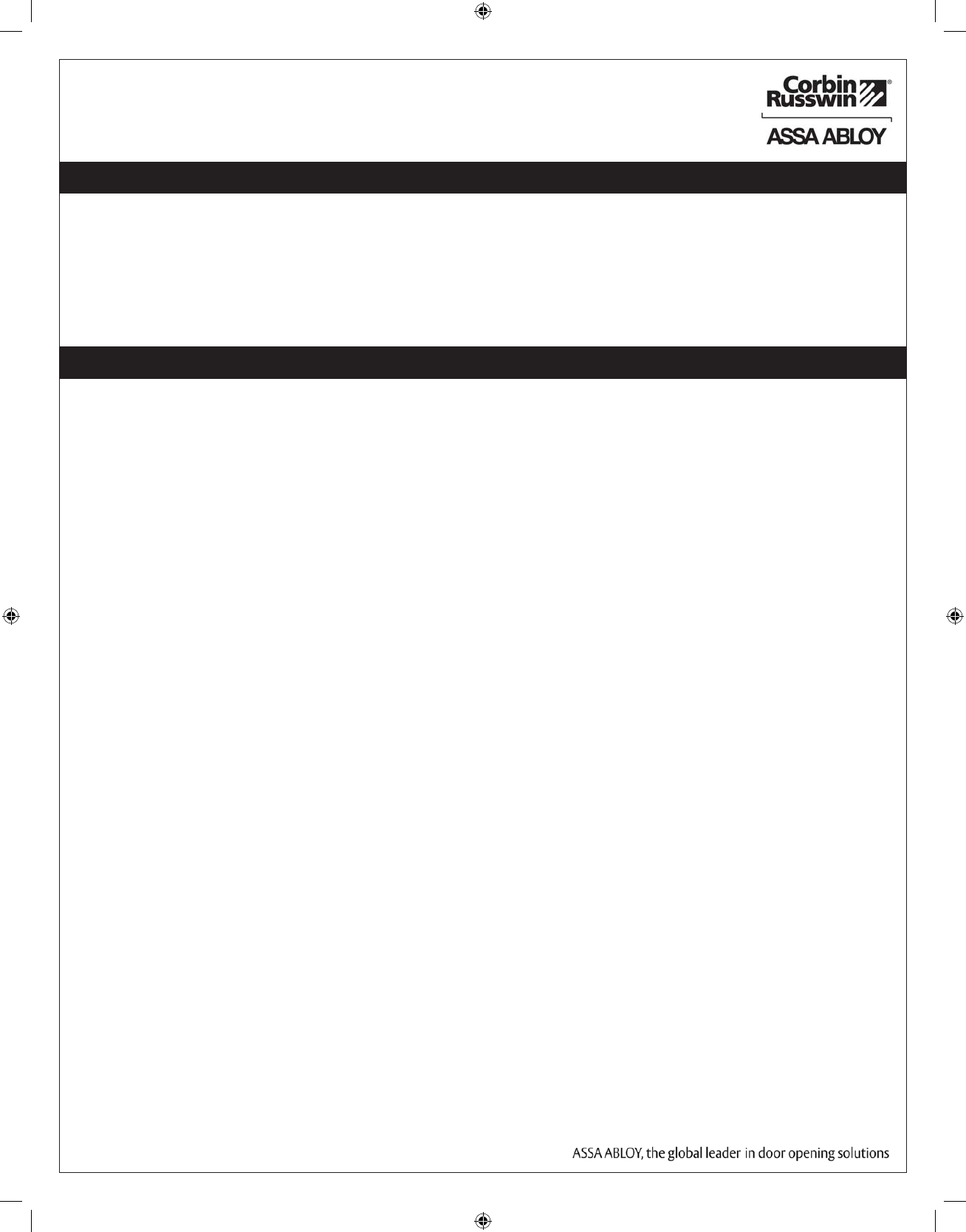
IN100 Mortise Lock
3
Copyright © 2016 Corbin Russwin, Inc., an ASSA ABLOY Group company.
All rights reserved. Reproduction in whole or in part without the
express written permission of Corbin Russwin, Inc. is prohibited.
To comply with “Fire Listed” doors, the batteries must be replaced with alkaline batteries only.
• Latch – Stainless Steel (Easily field reversible
without disassembling lock body)
• Deadbolt – Stainless Steel
• Auxiliary Latch – Stainless steel, non-handed
• Door Thickness – 1-3/4” Standard; can be
furnished for other door thicknesses upon
request. Consult factory.
• Case – 12 gauge heavy duty wrought steel
2) General Description
3) Specifications / Features
The Corbin Russwin® IN100 mortise lock with Aperio™ Technology makes it easy and cost-effective to bring
access control to more doors. It uses local wireless communication between the lock and an Aperio hub to
connect to an access control system, eliminating the greatest cost and inconvenience of traditional access
control – the wiring at the door. The IN100 utilizes HID® 125 kHz prox or 13.56 MHz iCLASS® smart card
technology, and all technology features are supported by the physical security of Corbin Russwin
ANSI/BHMA Grade 1 hardware.
This product is operated by six (6) “AA” alkaline batteries. Corbin Russwin mortise locks are designed with
quality components to provide high security, performance and durability.
Electronic Specifications
**For specific security information, please contact
your local ASSA ABLOY Door Security Solutions
sales consultant or call 800-810-WIRE.
• Input Power: DC 9V, 1.5A (6 AA alkaline batteries)
• Optional hard-power 12VDC to 24VDC
• HID® multiCLASS SE® technology offers support
for the following credentials:
• High Frequency (13.56 MHz):
• HID iCLASS®
• HID iCLASS SE® (SIO-enabled)
• HID iCLASS® Seos™
• HID MIFARE® SE
• HID DESfire® EV1 SE
• MIFARE Classic
• DESfire EV1
• Low Frequency (125 kHz):
• HID Prox®
• NFC-enabled Mobile Phones
• Uses low-rate wireless personal area networks
(IEEE 802.14.4)
• Multiple time zone and holiday access scheduling
• First-in unlock or automatic unlock configuration,
based on specified time schedule
• Uses AES 128-bit wireless encryption**
• Privacy button
• Outside lever controlled by reader or key
retracts latch
• Inside Lever produces REX (request to exit) signal
and retracts latch and deadbolt*
• UL fire listed
• May be used for both indoor and exterior applications
• A weather-protective gasket is required for
exterior applications
Hardware Specifications
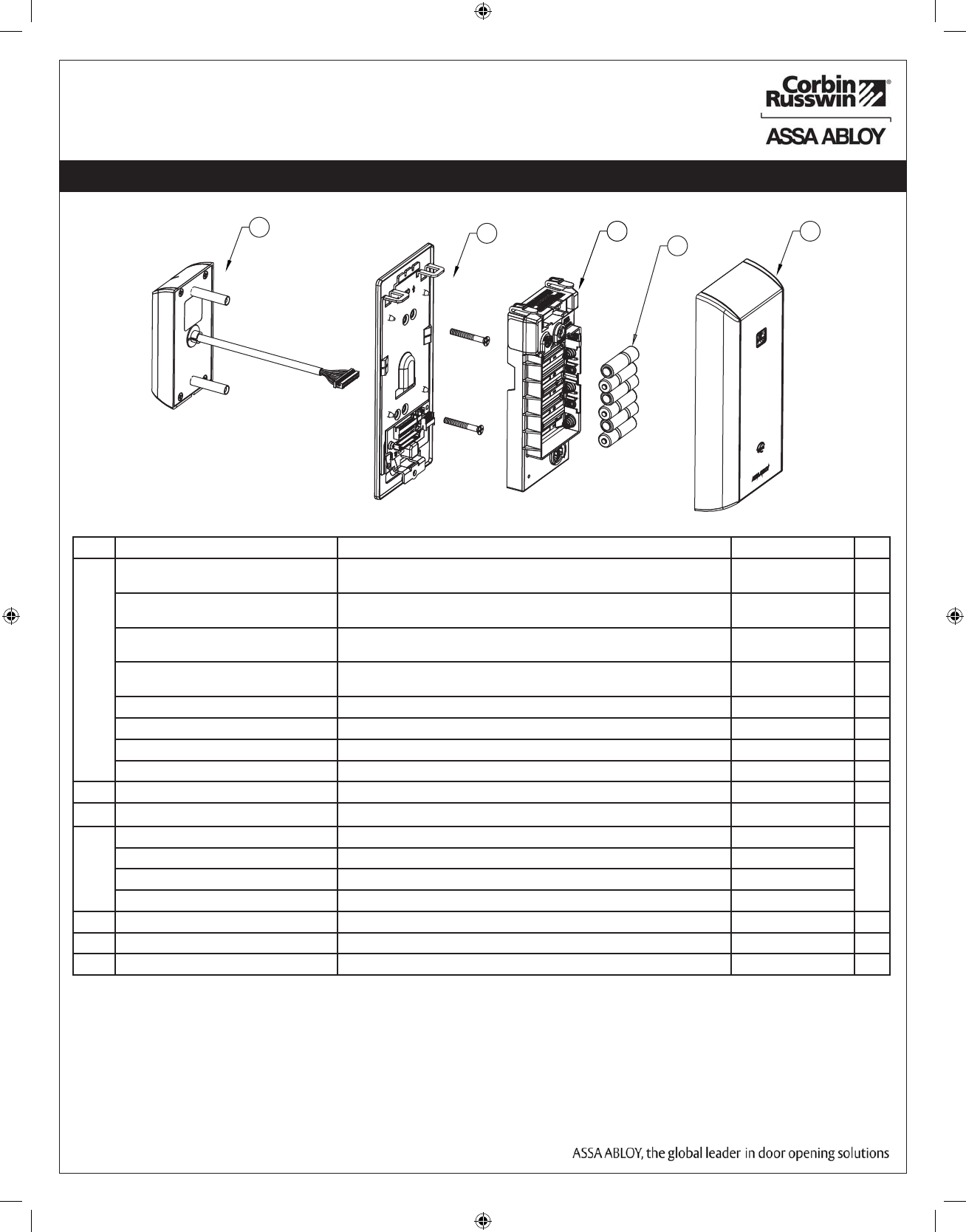
IN100 Mortise Lock
4
Copyright © 2016 Corbin Russwin, Inc., an ASSA ABLOY Group company.
All rights reserved. Reproduction in whole or in part without the
express written permission of Corbin Russwin, Inc. is prohibited.
4) Product Illustrations
** Specify finish
ITEM PART NUMBER/ORDER STRING DESCRIPTION COLOR/TRIM QTY
1 IN-100-EM01[locktype]*-IP-B HID iCLASS®, HID iCLASS SE® (SIO-enabled), HID iCLASS® Seos™, HID MIFARE®
SE, HID DESfire® EV1 SE, HID Prox®, NFC-enabled mobile phones
Black 1
IN-100-EM01[locktype]*-IP-W HID iCLASS®, HID iCLASS SE® (SIO-enabled), HID iCLASS® Seos™, HID MIFARE®
SE, HID DESfire® EV1 SE, HID Prox®, NFC-enabled mobile phones
White 1
IN-100-EM01[locktype]*-IP-MB-[finish]** HID iCLASS®, HID iCLASS SE® (SIO-enabled), HID iCLASS® Seos™, HID MIFARE®
SE, HID DESfire® EV1 SE, HID Prox®, NFC-enabled mobile phones
Black with metal trim 1
IN-100-EM01[locktype]*-IP-MW-[finish]** HID iCLASS®, HID iCLASS SE® (SIO-enabled), HID iCLASS® Seos™, HID MIFARE®
SE, HID DESfire® EV1 SE, HID Prox®, NFC-enabled mobile phones
White with metal trim 1
IN-100-EM01[locktype]*-IPS-B All credentials supported by the IP option plus MIFARE Classic and DESfire EV1 Black 1
IN-100-EM01[locktype]*-IPS-W All credentials supported by the IP option plus MIFARE Classic and DESfire EV1 White 1
IN-100-EM01[locktype]-IPS-MB-[finish]** All credentials supported by the IP option plus MIFARE Classic and DESfire EV1 Black with metal trim 1
IN-100-EM01[locktype]-IPS-MW-[finish]** All credentials supported by the IP option plus MIFARE Classic and DESfire EV1 White with metal trim 1
2 782F718 Inside Mounting Kit (mounting plate & hardware) 1
3 N/A AA battery 6
4 820F489 Inside Escutcheon Black 1
820F499 Inside Escutcheon White
820F525 FIN* Inside Escutcheon Black with metal trim
820F535 FIN* Inside Escutcheon White with metal trim
5 FM355 Field prep template (not shown) 1
6 T31202 Door manufacturers template (not shown) 1
-- FM403 Instructions (this manual) 1
15
4
1
2
* ML20133/36 (example: IN-100-EM01ML20136-IP-B)
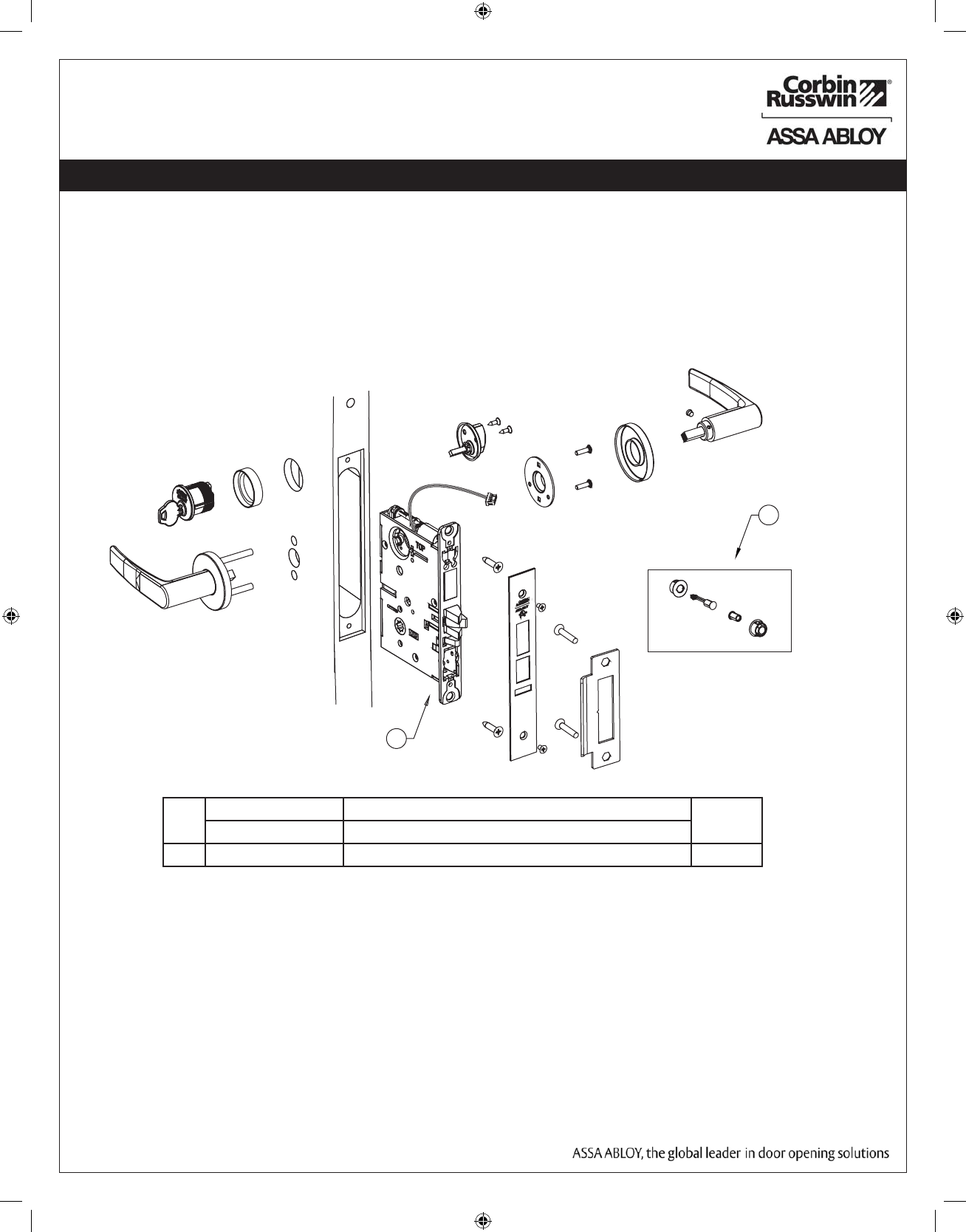
IN100 Mortise Lock
5
Copyright © 2016 Corbin Russwin, Inc., an ASSA ABLOY Group company.
All rights reserved. Reproduction in whole or in part without the
express written permission of Corbin Russwin, Inc. is prohibited.
Tools Required:
• Phillips Screw Driver #2, #3
• Flat Blade Screw Driver (Standard size)
• 1/8” Security Allen Wrench (supplied
• 7/64” Allen Wrench (supplied)
4) Product Illustrations (Continued)
1 784F848[handing]*26D ML20133/ML20134 Lock Case (No Deadbolt)** 1
784F858[handing]*26D ML20135/ML20136 Lock Case (With Deadbolt)**
2 783F619 DPS (Door Position Switch) Kit 1
*Replace with handing (L, LR, R, RR)
1*
2
For parts not listed, refer to ML2000 Parts and Service Manual
**Escape return functionality is not available with the IN100 ML201xx mortise lock.
820F609
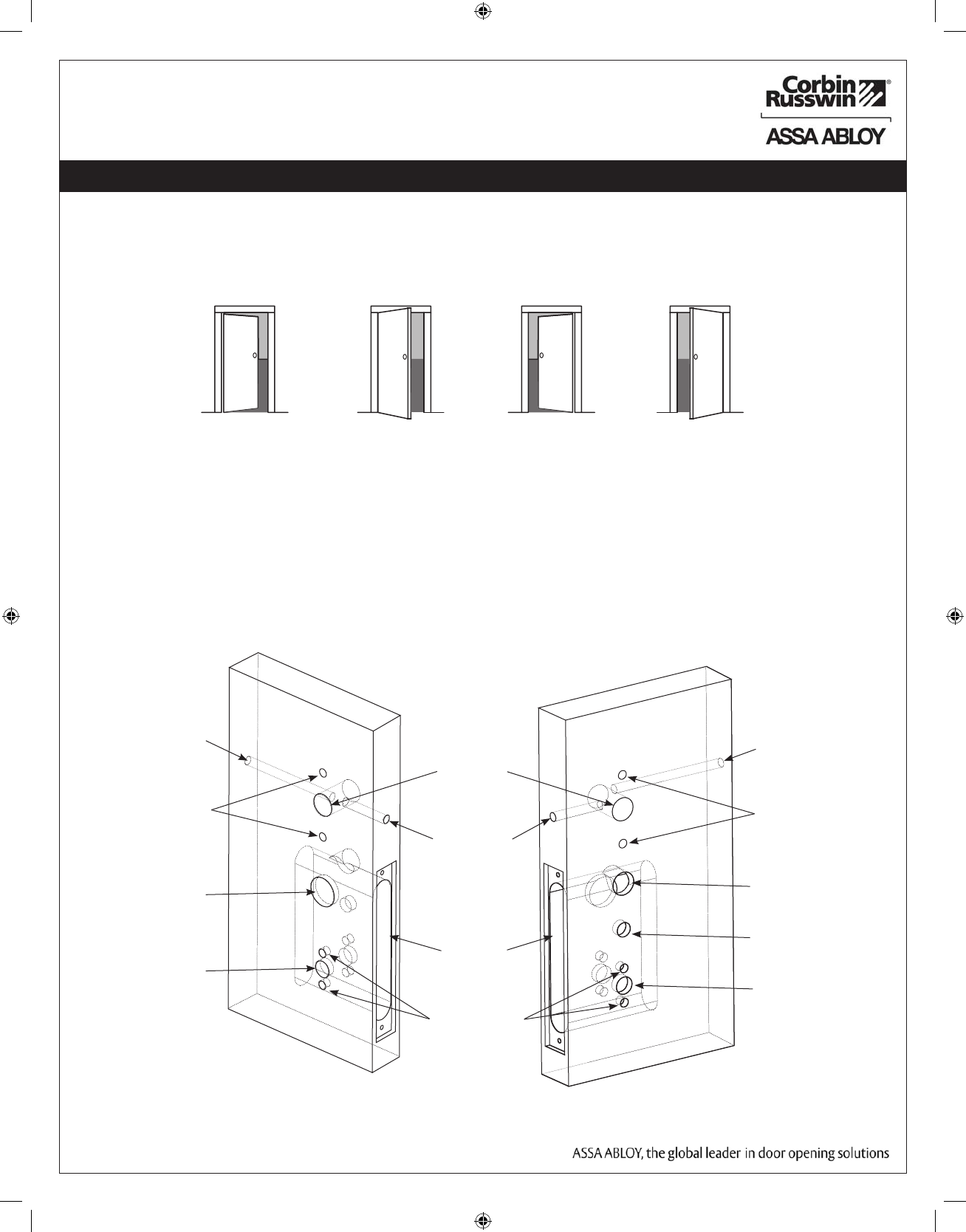
IN100 Mortise Lock
6
Copyright © 2016 Corbin Russwin, Inc., an ASSA ABLOY Group company.
All rights reserved. Reproduction in whole or in part without the
express written permission of Corbin Russwin, Inc. is prohibited.
5) Installation Instructions
Left Hand
Hinges Left.
Open Inward.
“LH”
Left Hand
Reverse Bevel
Hinges Left.
Open Outward
“LHRB”
Right Hand
Hinges Right.
Open Inward.
“RH”
Right Hand
Reverse Bevel
Hinges Right.
Open Outward
“RHRB”
Illustrations shown are as viewed from the outside or secure side of opening.
2. Door Preparation
Outside Face of
Door
Inside Face of
Door
1. Verify Hand and Bevel of door
Prep door according to supplied door marker (FM355). For door manufacturer templates
visit www.corbinrusswin.com and reference template # T31202.
Fig. 1
Fig. 2
Through-bolt Hole
Outside Cylinder Hole
(only with cylinder
installation)
Lever Handle Hole
External DPS
Hole
Cable Hole
Through-bolt Hole
Inside of Lock body
Wire Hole
Thumb Turn Lever Hole
Lever Handle Hole
Lever Post Holes
Mortise
Pocket
Raceway for Optional
Remote Power Raceway for Optional
Remote Power
Wood Door
shown
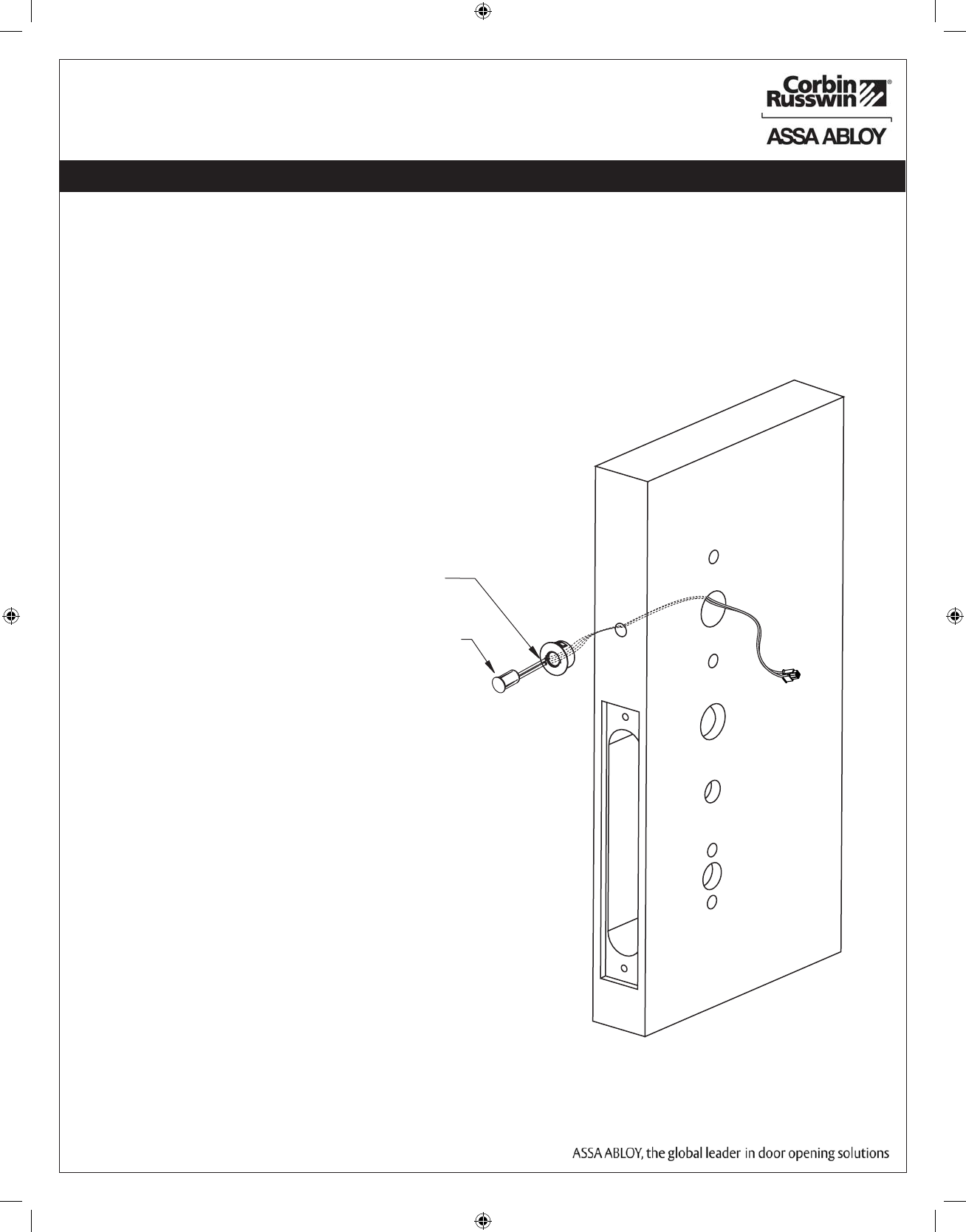
IN100 Mortise Lock
7
Copyright © 2016 Corbin Russwin, Inc., an ASSA ABLOY Group company.
All rights reserved. Reproduction in whole or in part without the
express written permission of Corbin Russwin, Inc. is prohibited.
Illustrations shown are as viewed from the outside or secure side of opening.
a. Push wires through raceway toward lock prep.
b. Push DPS firmly into place by hand.
Note: DO NOT TAP SWITCH WITH ANY TOOL.
c. Install magnet into door frame. Push firmly into place by hand.
See instruction A7983.
3. Install Door Position Switch (DPS)
CAUTION: if DPS is not installed or is installed improperly,
door status monitoring features will not function.
5) Installation Instructions (Continued)
Collar is used only
with metal doors
Door Status Switch
Inside of Door
Fig. 3
*Only required on the ML201xx lock body (ML202xx has an integrated DPS)
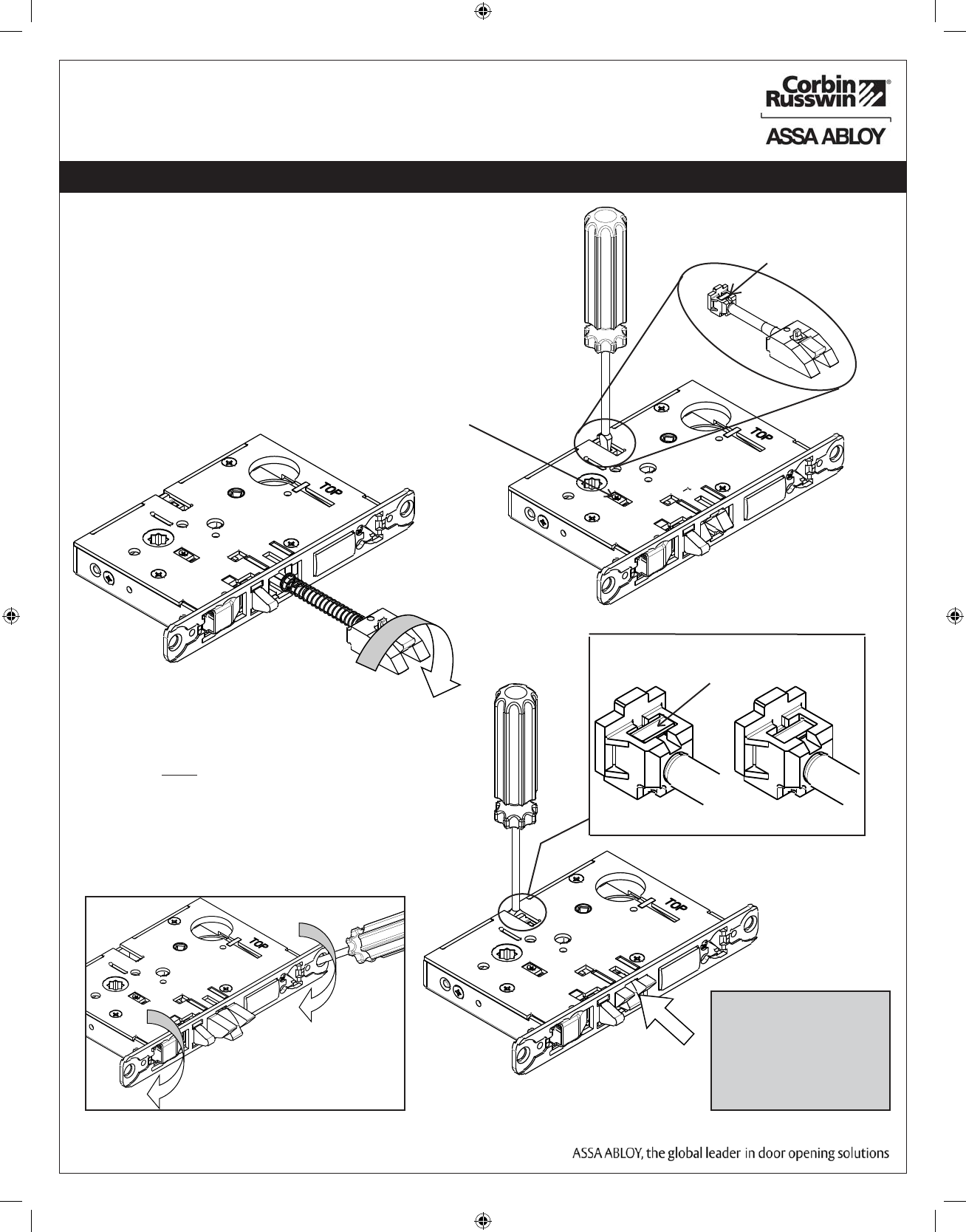
IN100 Mortise Lock
8
Copyright © 2016 Corbin Russwin, Inc., an ASSA ABLOY Group company.
All rights reserved. Reproduction in whole or in part without the
express written permission of Corbin Russwin, Inc. is prohibited.
RED Locking Screw
d. Push in latch while holding screw driver
behind latch tail (Fig. 3)
Note: Push in latch until catch plate is no
longer depressed (Fig. 4)
e. Rotate lock front to match bevel of door
as shown (Fig. 5)
Catch Plate
MAKE SURE CATCH PLATE IS
EVEN W/ TOP SURFACE
WARNING:
LOCK-IN CAN
OCCUR IF LATCH
IS NOT PROPERLY
INSTALLED
5) Installation Instructions (Continued)
4. Lock Handing Instructions
a. Move the Red locking screw to side of lock-body
being locked (Fig. 4a)
b. Push in latch then depress catch plate with screw
driver (Fig. 4a)
c. Pull latch out of lock-body and turn latch over (Fig. 4b)
Fig. 4a
Fig. 4b
Fig. 4d
Fig. 4c
Fig. 4e
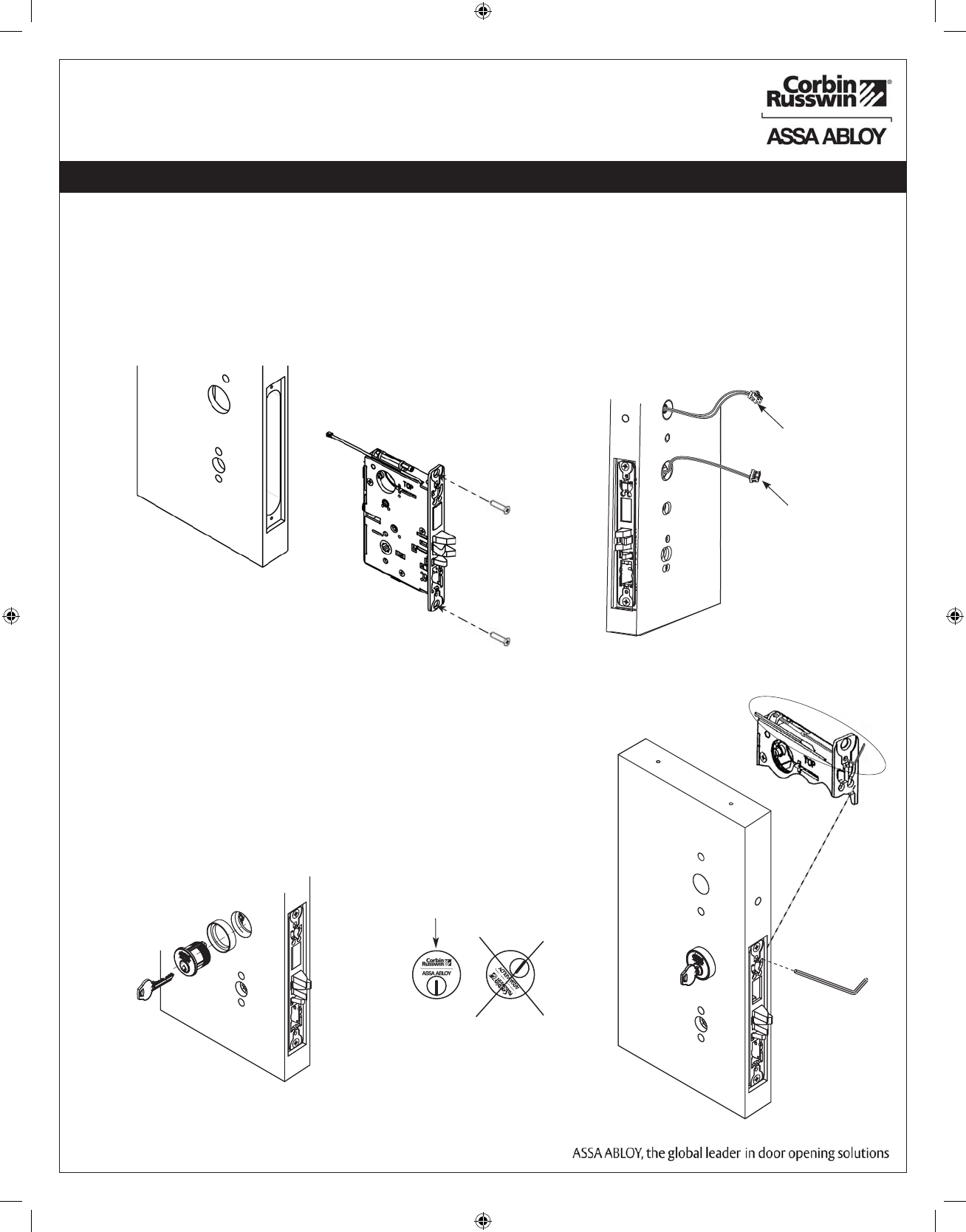
IN100 Mortise Lock
9
Copyright © 2016 Corbin Russwin, Inc., an ASSA ABLOY Group company.
All rights reserved. Reproduction in whole or in part without the
express written permission of Corbin Russwin, Inc. is prohibited.
5) Installation Instructions (Continued)
a. Feed wires through 1-5/16” diameter hole on INSIDE of door while installing lock body (Fig. 5a).
b. Pull wires through hole while inserting lock body. DO NOT push wires back into cylinder hole (Fig. 5b).
Important: Door must remain open during installation. Use door stop.
c. Install, but do not tighten two #12 x 1” combination screws through lock body (Fig. 5a).
Fig. 5a
Fig. 5b
Outside Face of Door
(2) #12 x 1”
Do not tighten
Inside Face of Door
From Lock Body
6. Install Cylinder:
Position cylinder so that the logo is right-
side up.
Correct Incorrect
Fig. 6a1
Fig. 6a Fig. 6b
7/64" Allen Wrench
DPS
5. Install Lock Body in Door:
a. Slide cylinder through collar. Thread cylinder into lock body
(Fig. 6a).
Note: Make sure cylinder is oriented correctly (Fig. 6a1).
b. Tighten cylinder clamp using 7/64” allen wrench (Fig. 6b).
c. Turn the key to make sure that lock functions correctly
(latch, deadbolt, and key).
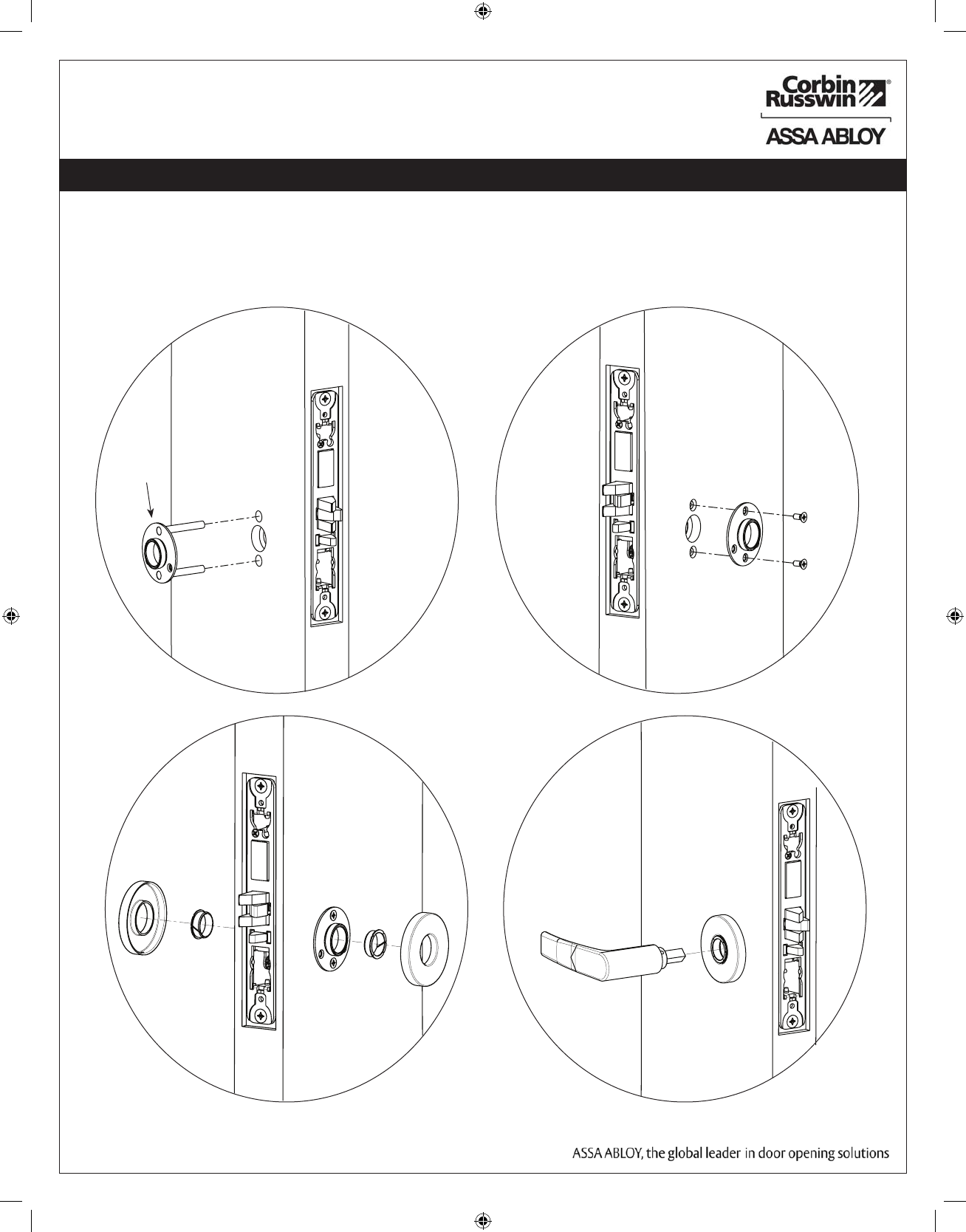
IN100 Mortise Lock
10
Copyright © 2016 Corbin Russwin, Inc., an ASSA ABLOY Group company.
All rights reserved. Reproduction in whole or in part without the
express written permission of Corbin Russwin, Inc. is prohibited.
7A. Install Standard Lever Trim:
(Refer to Step 7b on following pages for Museo® Trim):
Step 2 Step 3
Fig. 7c
Inside Face of Door
Fig. 7a
Inside Face of Door
Fig. 7b
Outside Face of Door
Outside Adapter Plate
Fig. 7d
Outside Face of Door
Step 1a Step 1b
5) Installation Instructions (Continued)
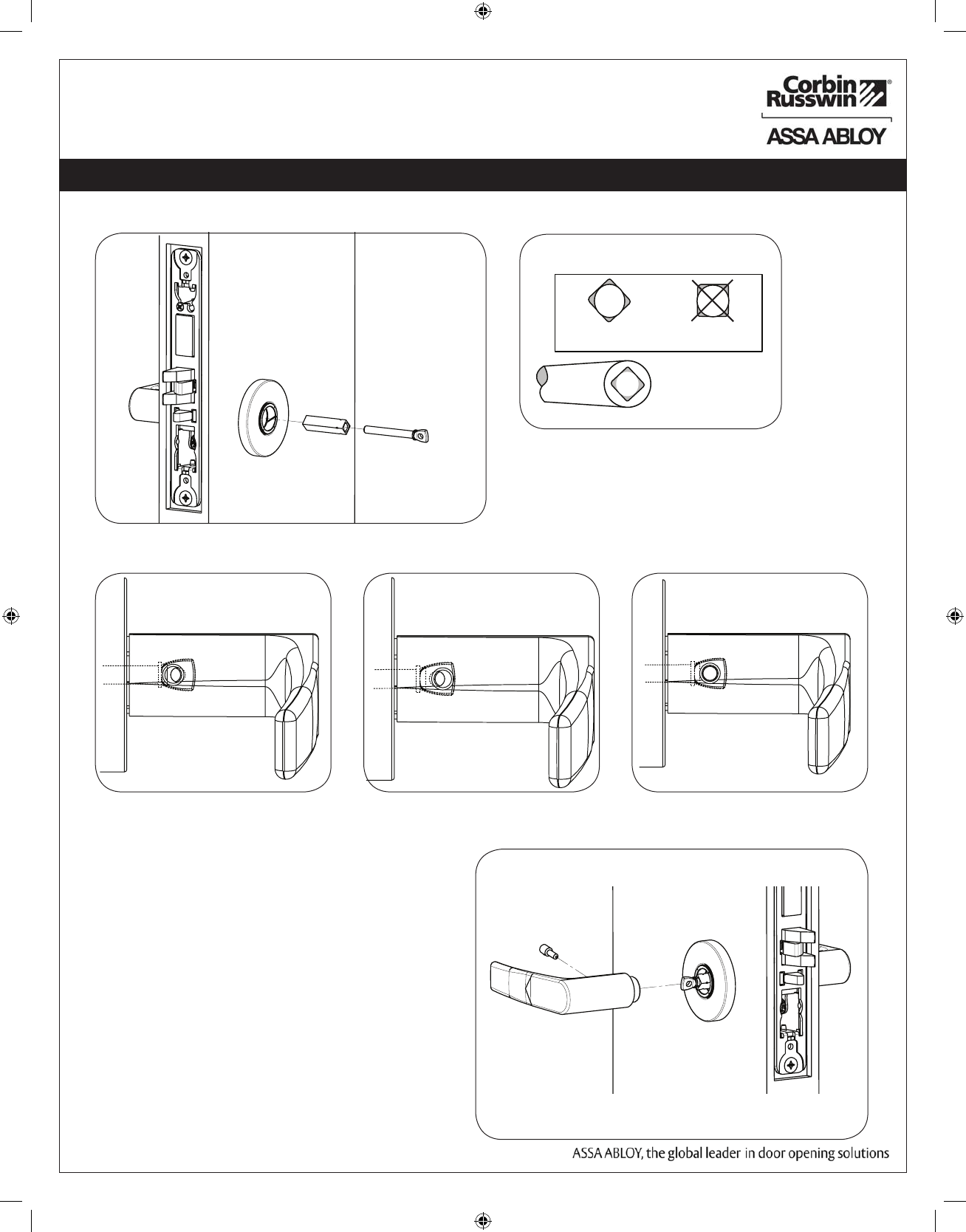
IN100 Mortise Lock
11
Copyright © 2016 Corbin Russwin, Inc., an ASSA ABLOY Group company.
All rights reserved. Reproduction in whole or in part without the
express written permission of Corbin Russwin, Inc. is prohibited.
Fig. 8a
Inside Face of Door
Step 4
Step 5 Align adjustment bolt with threaded hole in lever
Adjustment bolt needs
to be threaded in farther.
Adjustment bolt needs
to be unthreaded.
Adjustment bolt fully aligned.
Notes:
• Unthread adjustment bolt approximately four turns
for a good starting point (after being fully tightened).
• Make sure O/S lever is fully inserted into adapter
plate before aligning adjustment bolt.
STANDARD MUSÉO
kƒ„ƒ·
Use Correct Spindle Orientation
Good Bad
Lever Fig. 8b
5) Installation Instructions (Continued)
Inside Lever
Fig. 9a Fig. 9b Fig. 9c
Fig. 10
Step 6
Install I/S lever with set screw:
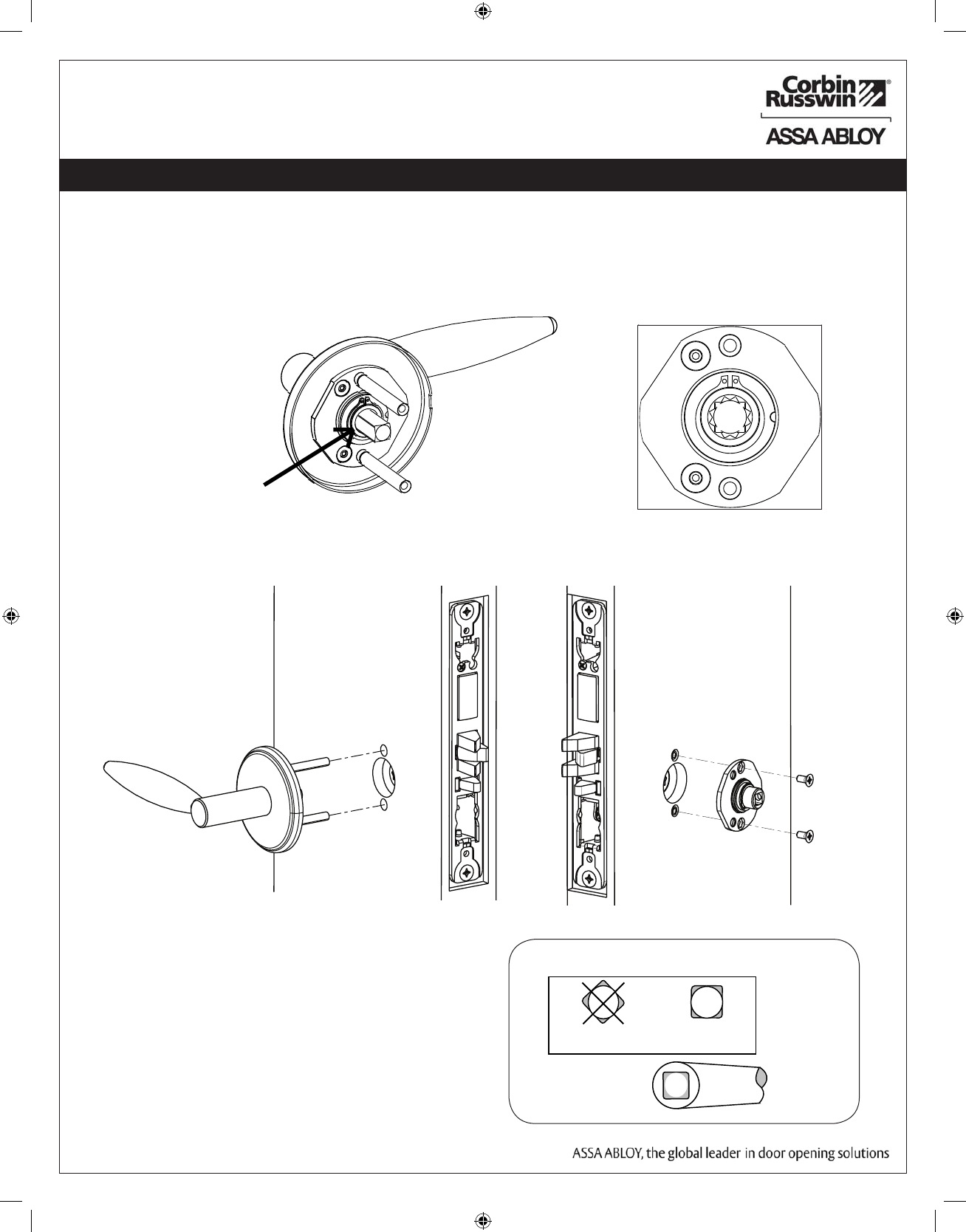
IN100 Mortise Lock
12
Copyright © 2016 Corbin Russwin, Inc., an ASSA ABLOY Group company.
All rights reserved. Reproduction in whole or in part without the
express written permission of Corbin Russwin, Inc. is prohibited.
NOTE: Spindle can
be used to help
thread hub into lever
Adapter Plate Hub
Step 1
Thread adapter plate hub into
lever and fully tighten
Step 2
Install O/S trim assembly and inside adapter plate
Step 3
7B. Install Museo® Trim:
5) Installation Instructions (Continued)
Use Correct Spindle Orientation
BAD GOOD
Lever
Outside Face of Door
Align adapter plate hub with square
hole in lever; keeping hub as tight
as possible
Inside Face of Door
Fig. 11a Fig. 11b
Fig. 12
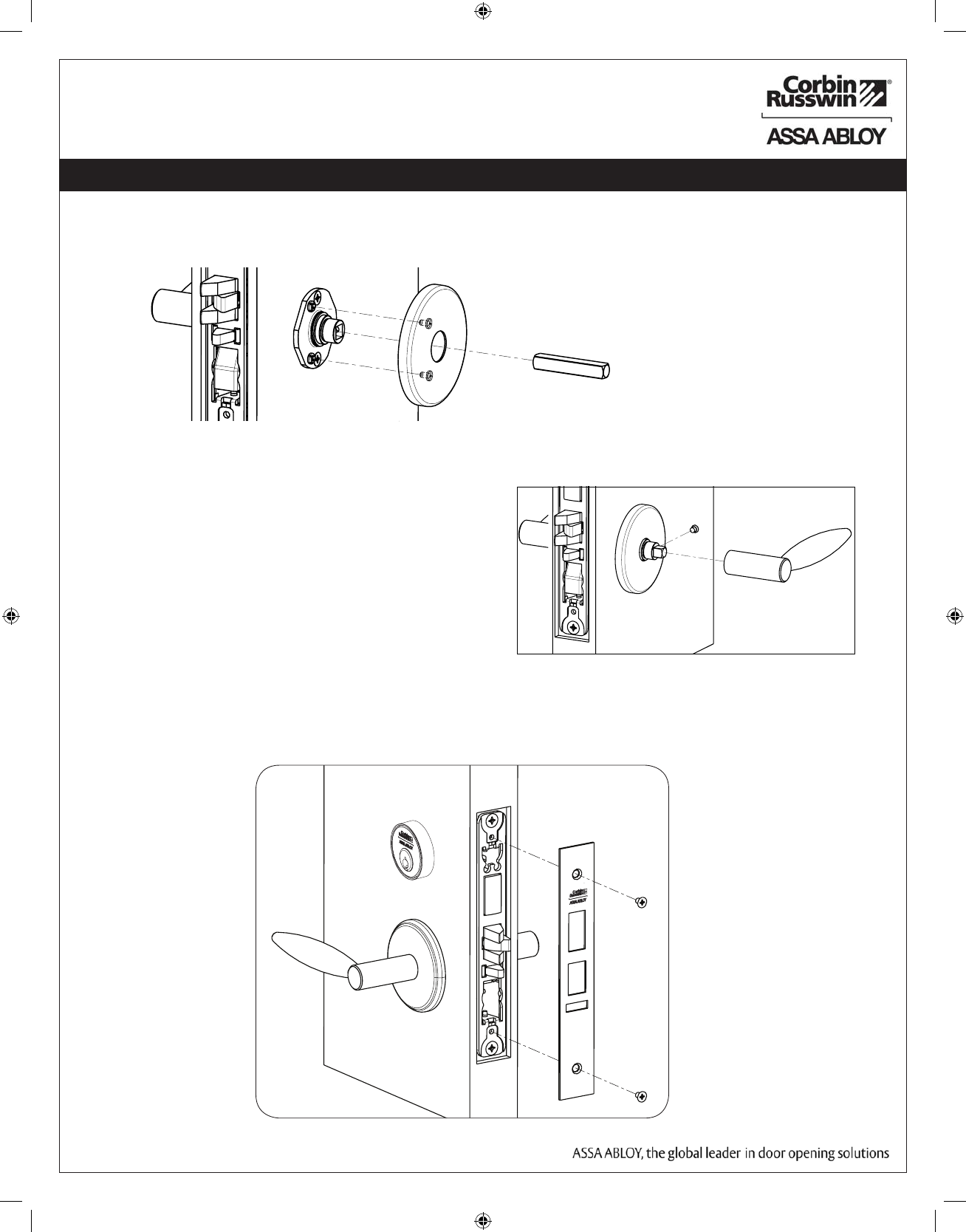
IN100 Mortise Lock
13
Copyright © 2016 Corbin Russwin, Inc., an ASSA ABLOY Group company.
All rights reserved. Reproduction in whole or in part without the
express written permission of Corbin Russwin, Inc. is prohibited.
5) Installation Instructions (Continued)
Install Armored Front:
a. Tighten (2) screws through lock body.
b. Attach armored front with two #8 x ¼” screws (Fig. 13c).
Install Spindle and Rose:
a. Align studs on rose with bushings in adapter plate.
Install I/S lever with set screw:
Step 4
Step 5
Step 6
Outside Face of Door
Fig. 13a
Fig. 13b
Fig. 13c
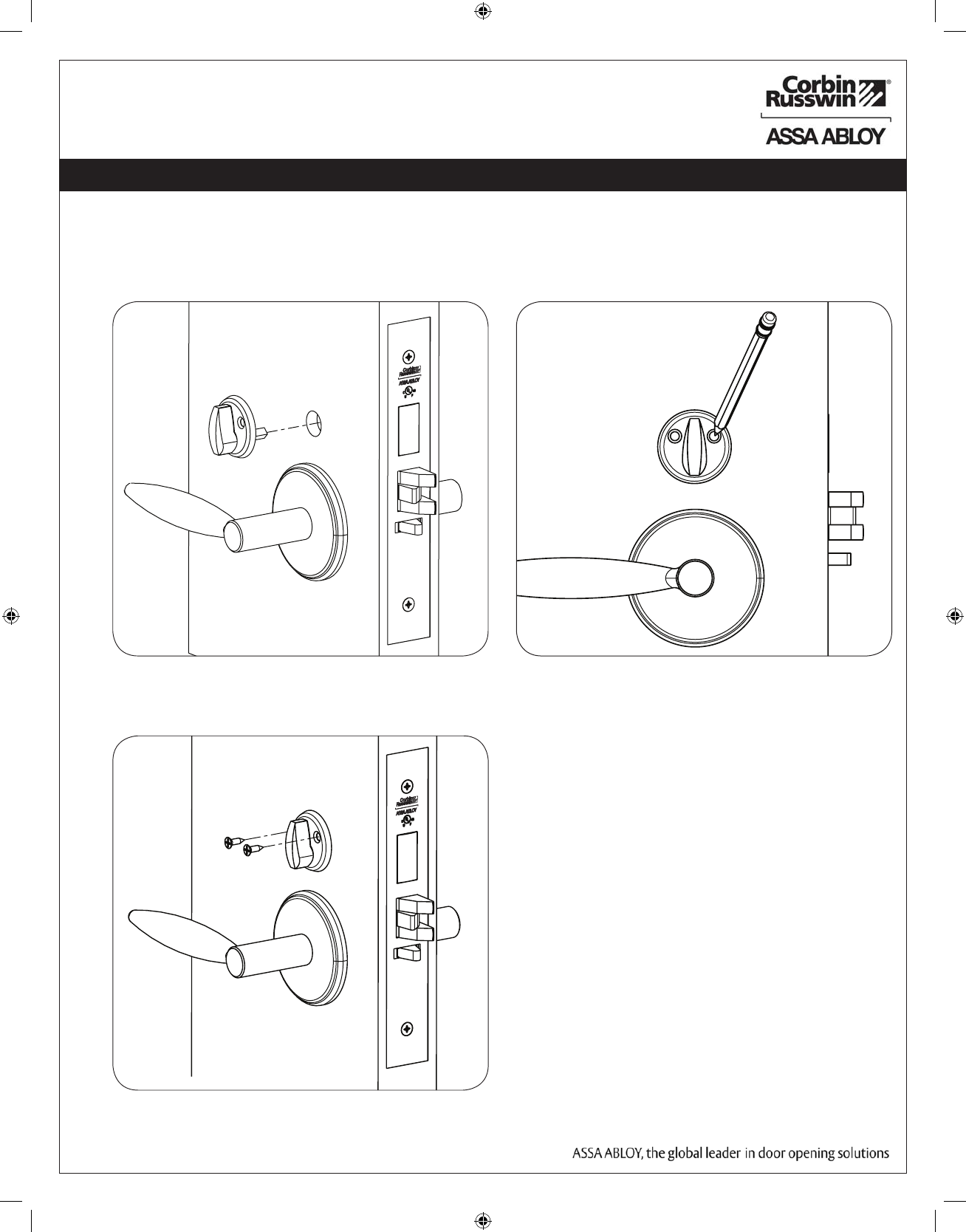
IN100 Mortise Lock
14
Copyright © 2016 Corbin Russwin, Inc., an ASSA ABLOY Group company.
All rights reserved. Reproduction in whole or in part without the
express written permission of Corbin Russwin, Inc. is prohibited.
5) Installation Instructions (Continued)
Step 1
8. Install Turn Piece:
Step 2
Step 3
Fig. 13d Fig. 13e
Fig. 13f
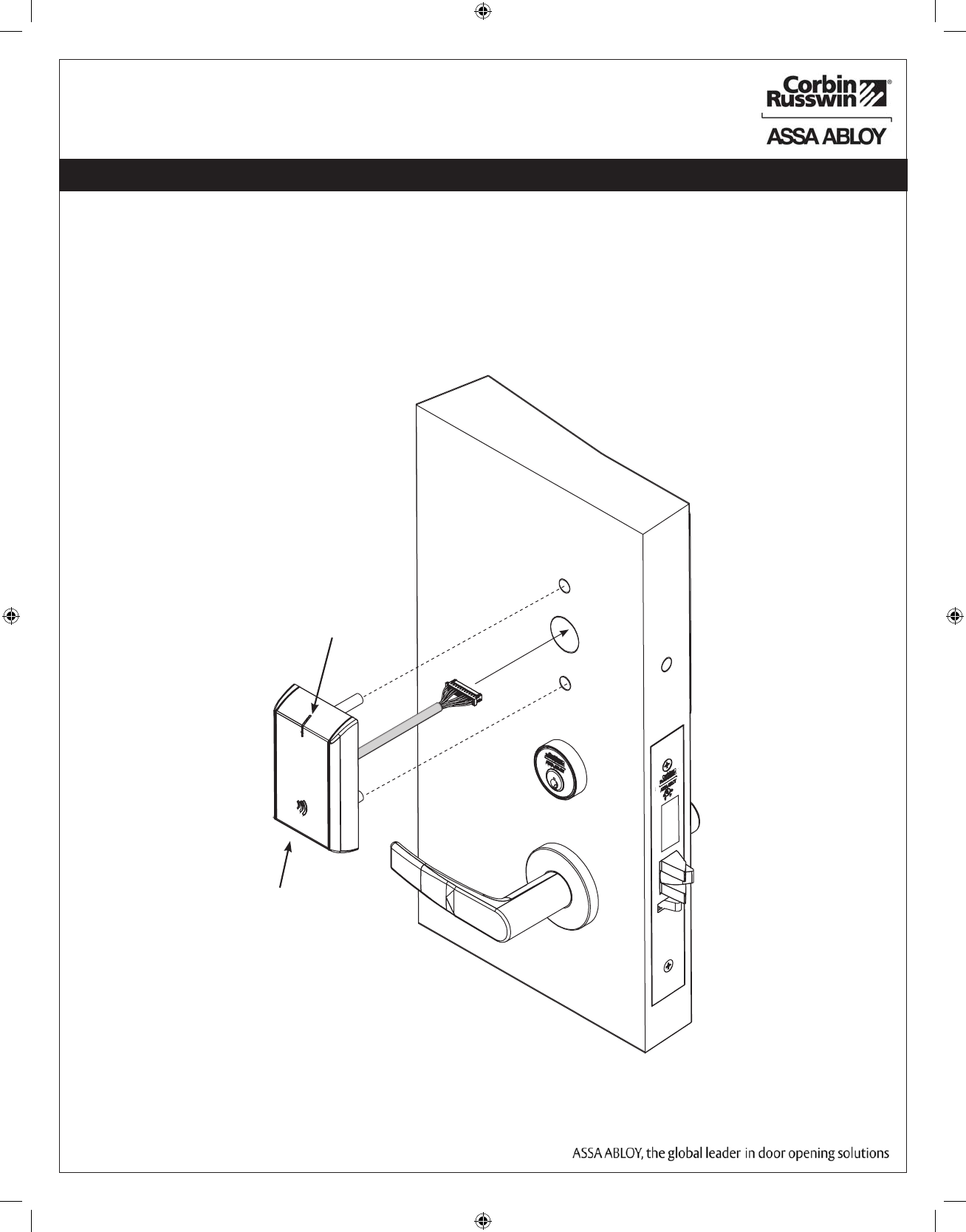
IN100 Mortise Lock
15
Copyright © 2016 Corbin Russwin, Inc., an ASSA ABLOY Group company.
All rights reserved. Reproduction in whole or in part without the
express written permission of Corbin Russwin, Inc. is prohibited.
9. Install Outside Reader and Inside Mounting Plate:
Fig. 14a
Outside Face of Door
Reader Assembly
with Harness
LED
5) Installation Instructions (Continued)
a. Orient the reader so the LED lens is at the top.
b. Feed the reader harness through the door (from outside to inside).
c. Install the reader to the outside of door by aligning the mounting posts with the door preparation holes.
Hold the reader flush against door while ensuring proper alignment.
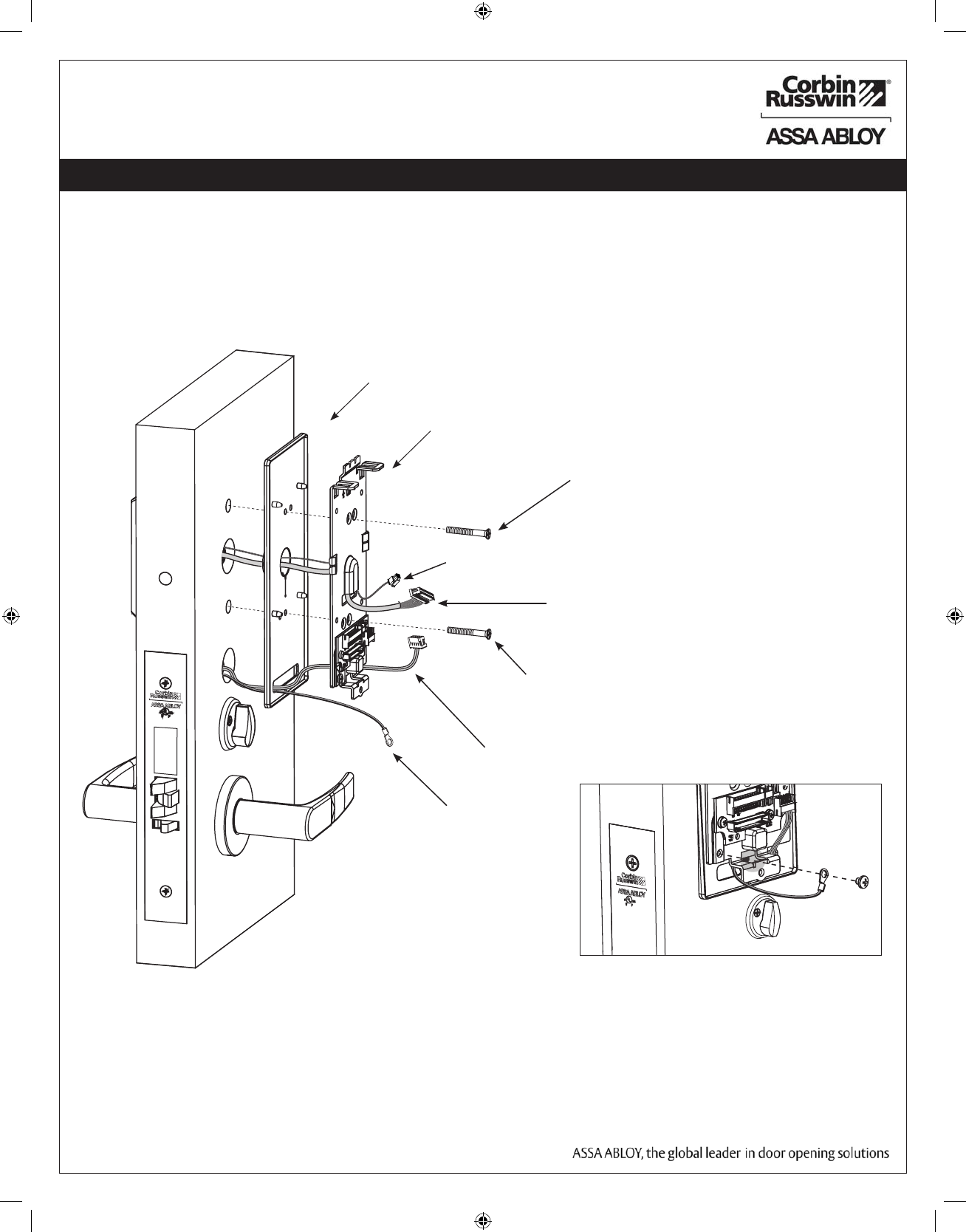
IN100 Mortise Lock
16
Copyright © 2016 Corbin Russwin, Inc., an ASSA ABLOY Group company.
All rights reserved. Reproduction in whole or in part without the
express written permission of Corbin Russwin, Inc. is prohibited.
5) Installation Instructions (Continued)
Fig. 14b
Ground Ring
Terminal
Lock Body
Harness
Through-bolt
Reader
Harness
Through-bolt
Inside
Mounting Plate
Gasket*
Door Position
Switch
*Gasket is required for outdoor installations. Do not use gasket for fire-rated openings.
If installing with gasket; separate gasket from mounting plate to feed cables/connectors through holes as
indicated (Fig. 14c).
Once cables/connectors are fed through, reattach gasket to mounting plate.
NOTE: Cable lengths exaggerated for illustrative purposes.
Inside Face of Door
Inside Face
of Door
Fig. 14c
g. Secure ground lug with #6-32 machine screw (Fig.10C).
d. Feed the reader harness and DPS connectors through the inside mounting assembly
(and gasket if required*). See Figure 11B.
IMPORTANT: Do not run wires through bottom flange hole in plate (Fig. 11B, C) - it will damage wires and
the controller connector. Route wires around flange, do not route wires through the flange hole (Fig. 11C).
e. Tuck excess cable into wire hole on inside of door.
f. Begin to secure the mounting assembly by partially tightening the (2) through-bolts on the
inside of the door while ensuring proper alignment as you secure the reader (Fig. 11B).
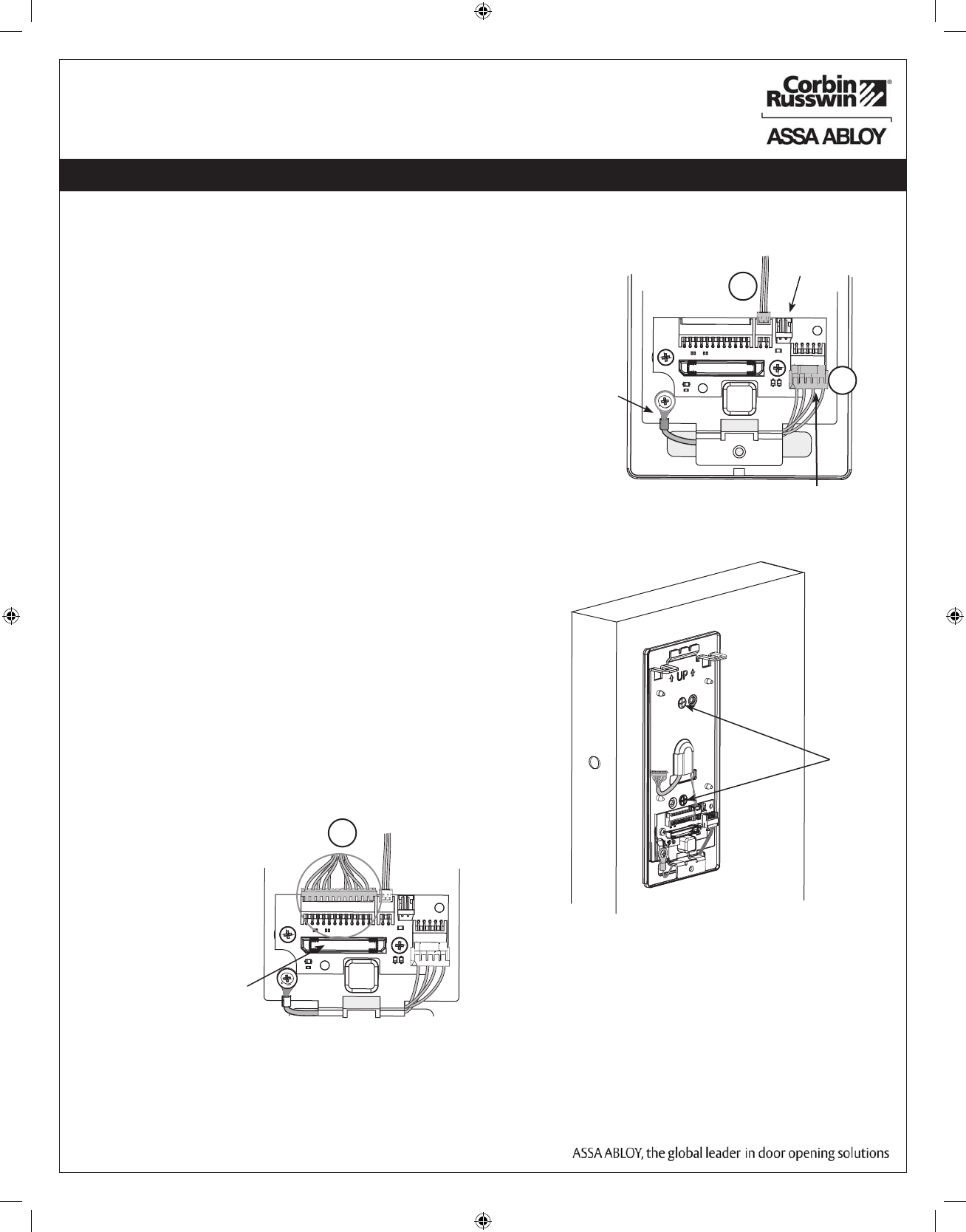
IN100 Mortise Lock
17
Copyright © 2016 Corbin Russwin, Inc., an ASSA ABLOY Group company.
All rights reserved. Reproduction in whole or in part without the
express written permission of Corbin Russwin, Inc. is prohibited.
5) Installation Instructions (Continued)
Secure the following connectors to their respective terminals (Fig. 10D):
A. Secure the 4-pin DPS connector.
B. Secure the 10-pin lock body assembly connector.
CAUTION - Do not touch or allow debris to enter connector contacts.
IMPORTANT: Do not run wires through bottom hole in plate - it will
damage wires and the controller connector.
Route wires around flange, do not route wires through
the flange hole (Fig. 10B, D).
E. Secure the 24-pin card reader connector (Fig. 10F).
Ground
Lug
DPS (4-pin)
A
Lock
Body
(10-pin)
Fig. 10D
B
Reader
(24-pin)
Board-to-Board
Connector
Fig. 10F
D
D. Secure the mounting assembly while ensuring proper
alignment of outside reader and tighten the (2) through-bolts
on the inside of the door to secure the reader (Fig. 10E).
Secure Mounting Plate
*NOTE: Optional 2-pin external 9-24VDC power connector.
9-24VDC
Power*
C. When all connections have been made, tuck excess cable
into wire hole on inside of door.
Fig. 10E
Fully
tighten
10. Installation of Connectors
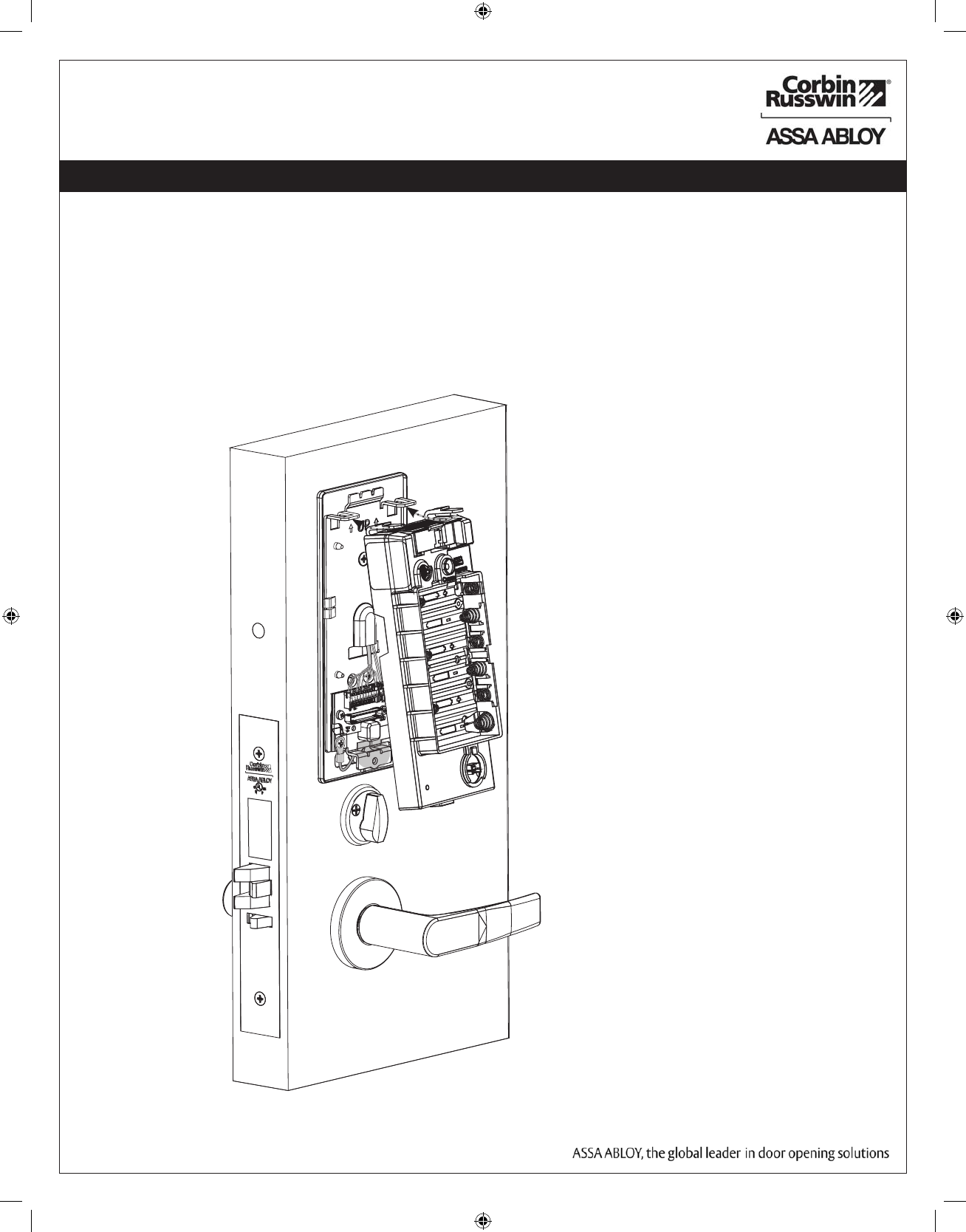
IN100 Mortise Lock
18
Copyright © 2016 Corbin Russwin, Inc., an ASSA ABLOY Group company.
All rights reserved. Reproduction in whole or in part without the
express written permission of Corbin Russwin, Inc. is prohibited.
5) Installation Instructions (Continued)
11. Installation of Inside Module Component Assembly
a. Insert top tabs of controller into slots on mounting plate (Fig. 17).
b. Ensure proper alignment of board-to-board connectors while pivoting bottom of controller
toward door until tab on bottom snaps securely into place on mounting plate.
CAUTION: To avoid possible damage to board-to-board connectors,
care should be taken when securing controller to mounting
plate. If there is resistance when securing, detach controller
to determine cause before re-attaching controller.
Fig. 17
Inside Face of
Door
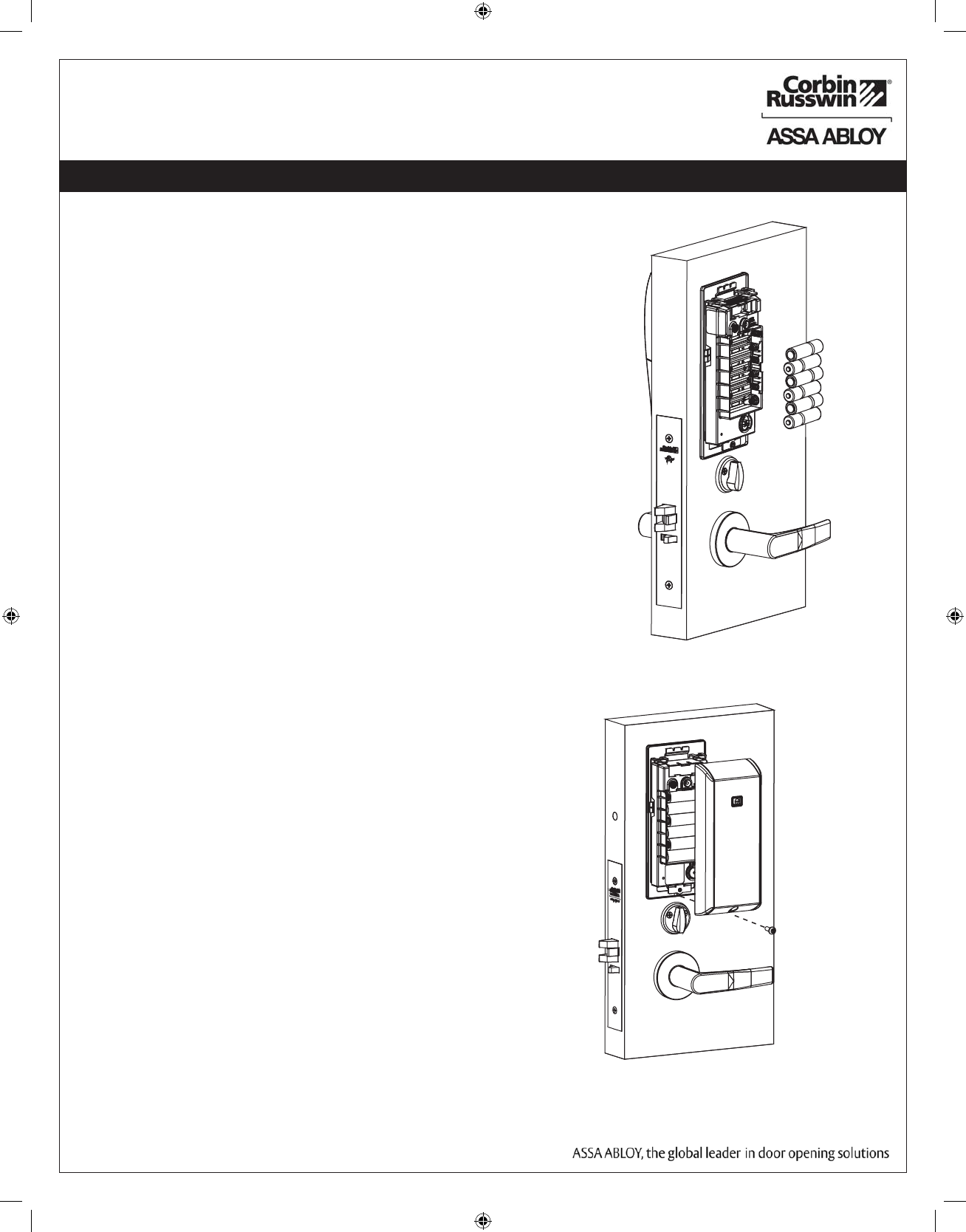
IN100 Mortise Lock
19
Copyright © 2016 Corbin Russwin, Inc., an ASSA ABLOY Group company.
All rights reserved. Reproduction in whole or in part without the
express written permission of Corbin Russwin, Inc. is prohibited.
Fig. 19
5) Installation Instructions (Continued)
a. Assemble cover by hooking top edge on inside
mounting plate.
b. Carefully press bottom of cover toward door with
out pinching or damaging any wires.
c. Fully secure cover by tightening the security screw
at bottom of cover (Fig.19), utilizing a security
allen wrench.
12. Installing Batteries
13. Inside Cover Installation
Fig. 18
a. Place (6) “AA” alkaline batteries in the compartment, being
careful to align polarity properly (Fig. 18).
b. After batteries are installed, there is a slight delay; then red and
green flash, audible “beep” and lock motor will cycle.
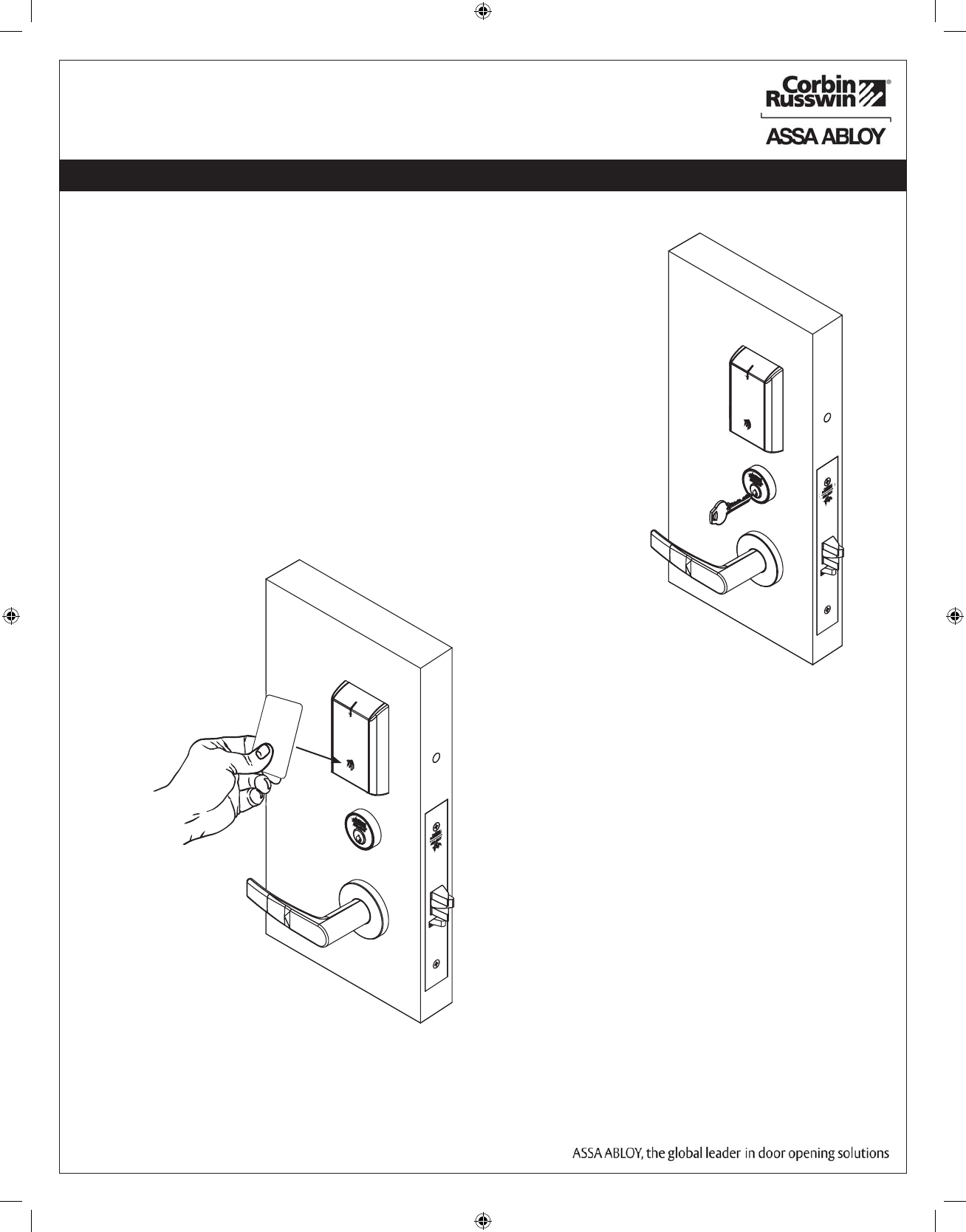
IN100 Mortise Lock
20
Copyright © 2016 Corbin Russwin, Inc., an ASSA ABLOY Group company.
All rights reserved. Reproduction in whole or in part without the
express written permission of Corbin Russwin, Inc. is prohibited.
6) Operational Check
Note: The credential should approach the inscription
on the reader as indicated (Fig. 20b) to ensure
that the credential is read properly.
Do not wave credential.
Fig. 20a
Fig. 20b
When lock is fully installed, perform the following steps:
a. Insert key into cylinder and rotate (Fig. 20a).
b. There should be no friction against lock case, wire harness or
any other obstructions.
c. Check that the key retracts the latch.
d. The key should rotate freely.
e. Try the inside lever; ensure it retracts latch.
f. Present a valid credential* (Fig. 20b) to unlock outside lever; turn
lever handle to ensure latch retracts.
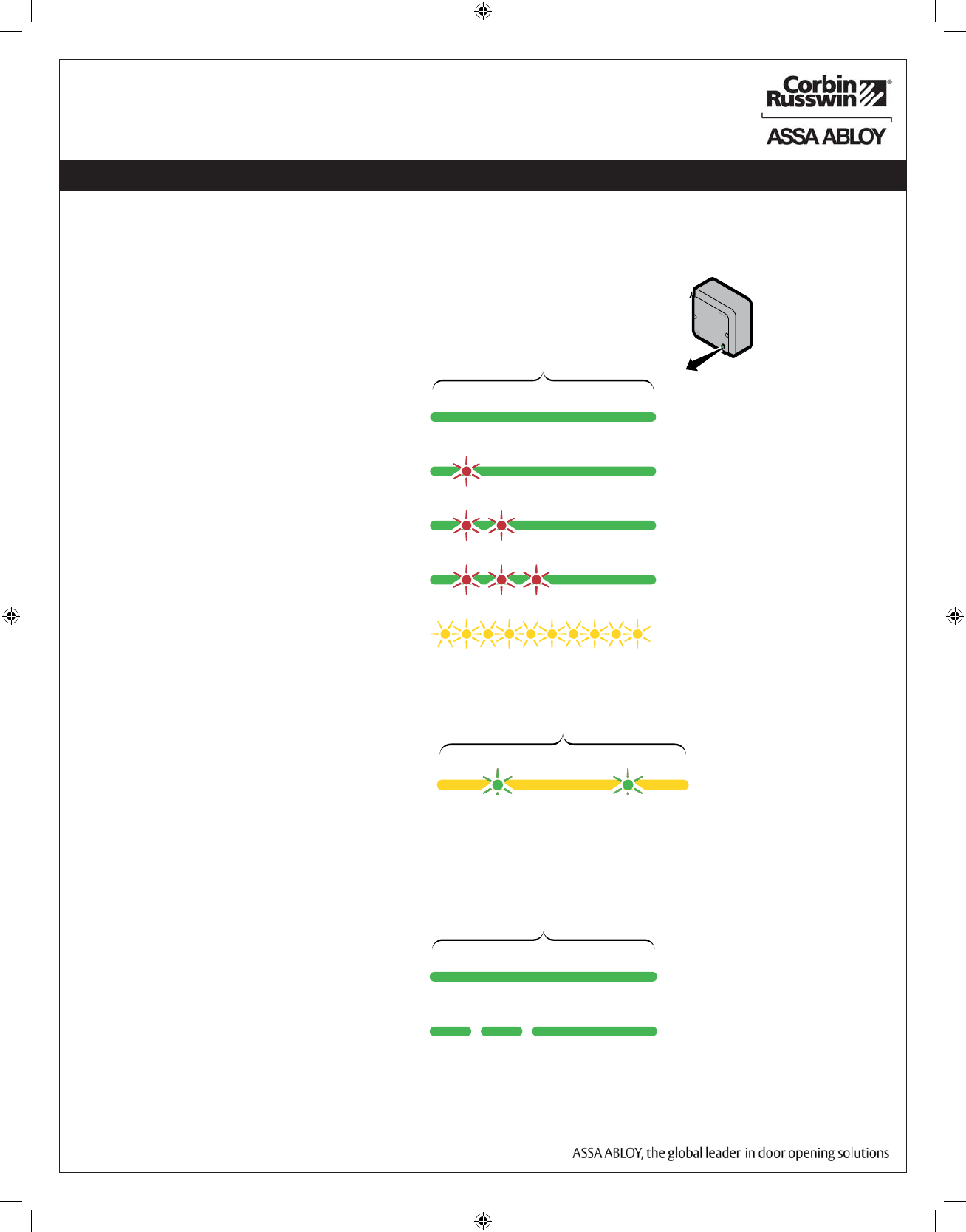
IN100 Mortise Lock
21
Copyright © 2016 Corbin Russwin, Inc., an ASSA ABLOY Group company.
All rights reserved. Reproduction in whole or in part without the
express written permission of Corbin Russwin, Inc. is prohibited.
Communication Hub LED indications
The communication hub has a single LED. It supports an optical scheme of red, green and yellow.
The indication scheme is described by the figures below:
Figure 1.
Communication hub normal
operation LED indication
2 sec.
Online Green
Aperio® lock Green + one
red flash
offline
EAC offline
Aperio® lock and Green + three
red flashes
EAC offline
UHF Yellow + off,
fast flash
communication
Some special LED indication schemes* are
used during lock maintenance actions:
2 sec.
Figure 2.
Communication hub maintenance
LED indication Pairing active Yellow + green
Ethernet LED indication
The LED on the AH40 communication hub* indicates both the status of
the Ethernet link level and ethernet communication:
2 sec.
Figure 3.
AH40 Communication hub
Ethernet LED indication Ethernet
link connected Green
Ethernet Green +
communication off fast flash
Green + two red flashes
7) LED Indications
*For more information, refer to Aperio Online Quick Installation Guide
(Document No: ST-001322-PF Date: 2015-12-23)
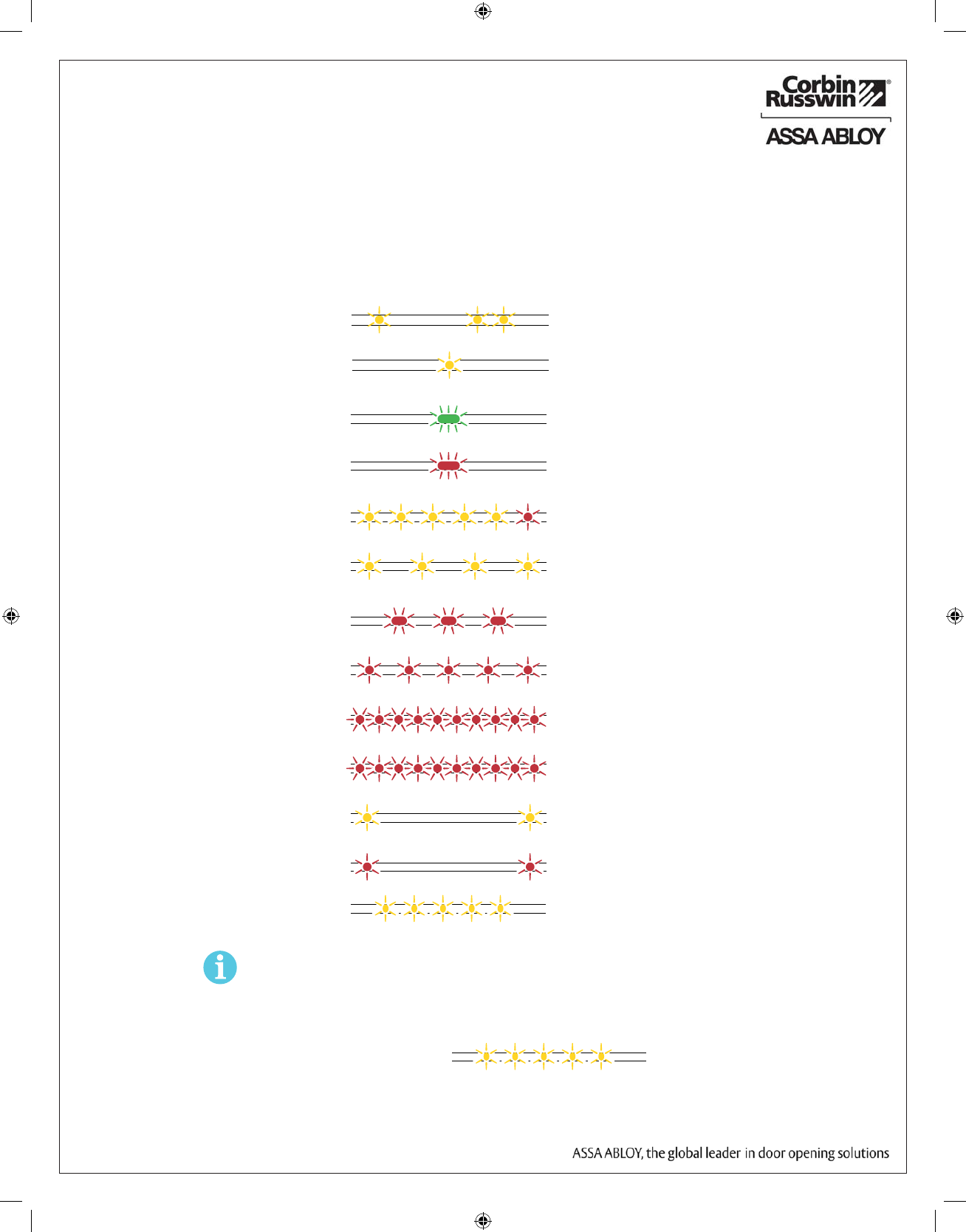
IN100 Mortise Lock
22
Copyright © 2016 Corbin Russwin, Inc., an ASSA ABLOY Group company.
All rights reserved. Reproduction in whole or in part without the
express written permission of Corbin Russwin, Inc. is prohibited.
1)
Lock LED indications
The lock has three LEDs. They support an optical scheme with red, yellow and green.
The indication scheme is described by the figures below:
Figure 4. Lock normal operation LED
indication
One yellow flash after card, two
flashes before PIN (.125 second)
Card + PIN access
(configurable)
Access granted, One green flash
(1 sec.)
EAC offline or online
Access denied, One red flash
(1 sec.)
EAC online
Force closed in remote Five yellow flashes and
open/office mode one red flash (.25 second)
Busy blink, com hub
busy with other locks
Continuous yellow flashes
(.25 seconds every second)
Access denied, Three red flashes
(.5 second each)
EAC offline
Lock mechanism is Continuous red flashes
blocked when closing (.125 seconds every 1 sec.)
Error in lock, Ten red flashes (.125 sec. each)
maintenance required (Repeated every 10 sec. if lock can’t close)
Ten red flashes (.125 sec. each)
repeated every 10 sec.
Tamper
Time to replace Continuous yellow flashes
(.25 seconds every 5 sec.)
the battery
Battery reached end
of life, lock disabled
Continuous red flashes (.25
seconds every 5 sec.)
1) When the lock mechanism is blocked (lock jammed) the lever must be turned to
release the lock mechanism.
Some special LED indication schemes are used during lock maintenance actions:
Figure 5. Lock hub normal
operation LED indication Enter configuration Five yellow flashes
(.125 second each)
mode
One yellow flash (.25 second)
Card access
(configurable)
Enter PIN
EAC response
time
V3 USB cable detection
action occurred
Five yellow flashes
(.25 second each)
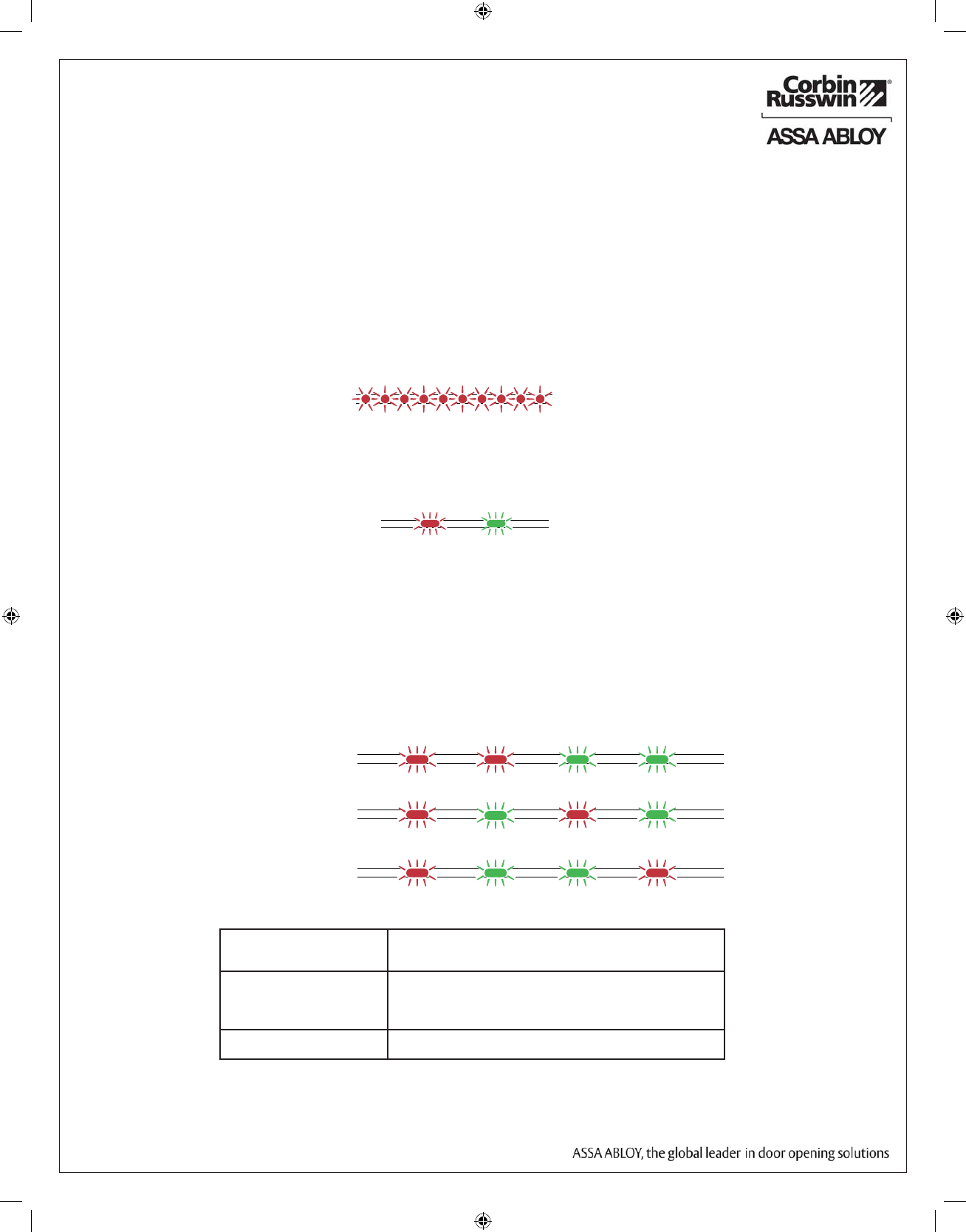
IN100 Mortise Lock
23
Copyright © 2016 Corbin Russwin, Inc., an ASSA ABLOY Group company.
All rights reserved. Reproduction in whole or in part without the
express written permission of Corbin Russwin, Inc. is prohibited.
Lock Self-Test LED indication
After replacing batteries, a Power on Self Test (POST) is performed. The result is indicated using
a series of red and green LED flashes as described by the figures below.
8.3.1 Battery not fully charged
8.3.2 Test pass
1 red (1s) + 1 green (1s), Power on self-test passed, see table below.
Error in lock, Ten red flashes (.125 sec. each)
maintenance required (Repeated every 10 sec. if lock can’t close)
LED indication after power up/replacement of the battery
Figure 6. Lock POST LED
indication
8.3.3 Test fail
1 red (1s) + 3 blinks (500ms, green or red), at least one test failed (red), see table below.
FATAL ERROR
CABLE ERROR
MECHANICAL ERROR
FATAL ERROR Tests core functionality - MCUs, memory and internal
communication, etc.
CABLE ERROR Tests communication between the different
parts in the system, i.e. different boards
connected with a wire.
MECHANICAL ERROR Test related to moving parts of the lock.
1 sec 0.5 sec 0.5 sec 0.5 sec
One red, one green flash
POST Successful (1 second)
If a fatal error is detected the lock will enter an Error state and continuously indicating fatal
error and will not read cards nor unlock.
Error in lock is an indication -10 quick (125ms) red blinks, that either new batteries are not at the
right voltage or a backward battery has been installed; battery not fully charged; energy counter
not reset or no Power on self-test done.
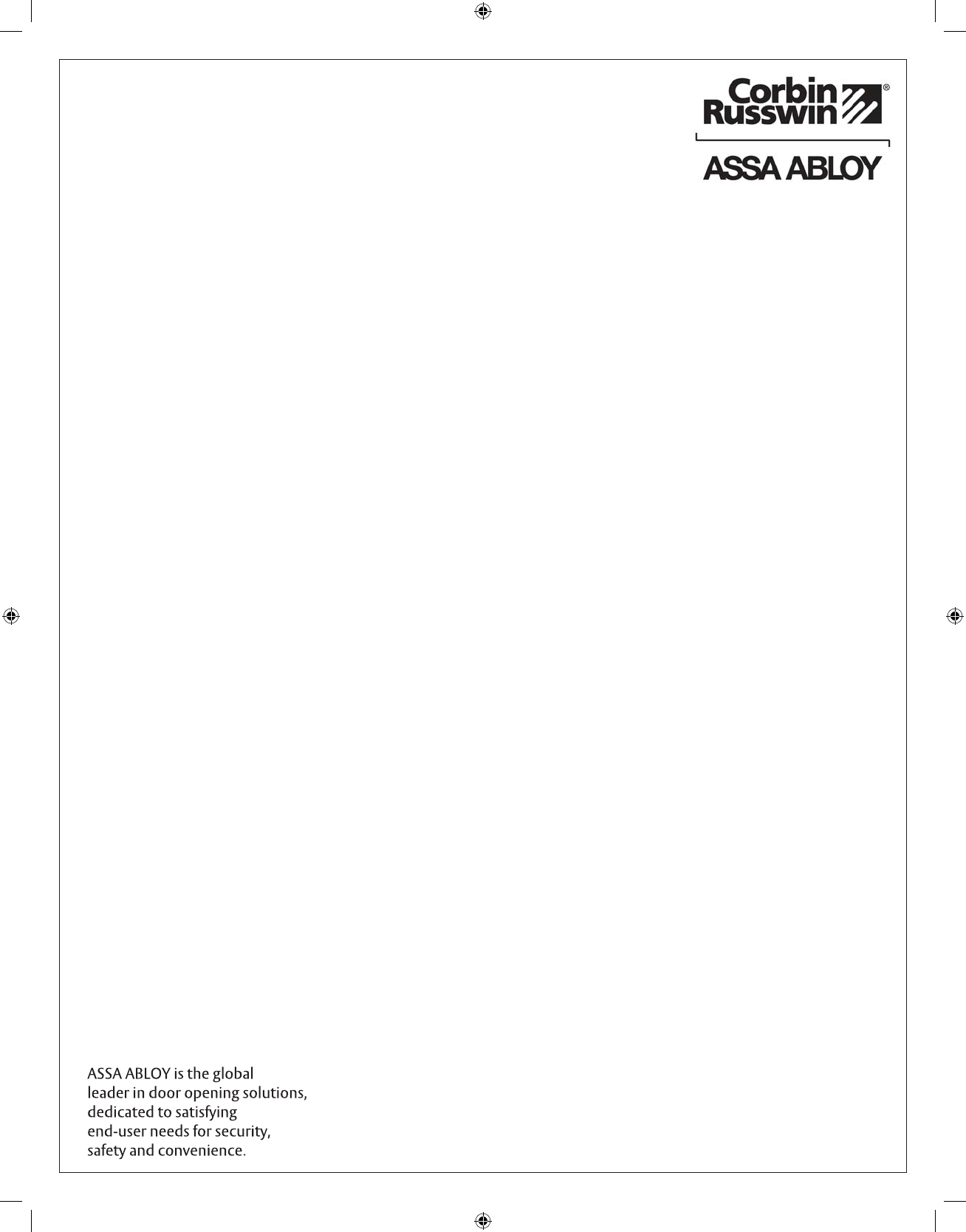
Copyright © 2016 Corbin Russwin, Inc., an ASSA ABLOY Group company.
All rights reserved. Reproduction in whole or in part without the
express written permission of Corbin Russwin, Inc. is prohibited.